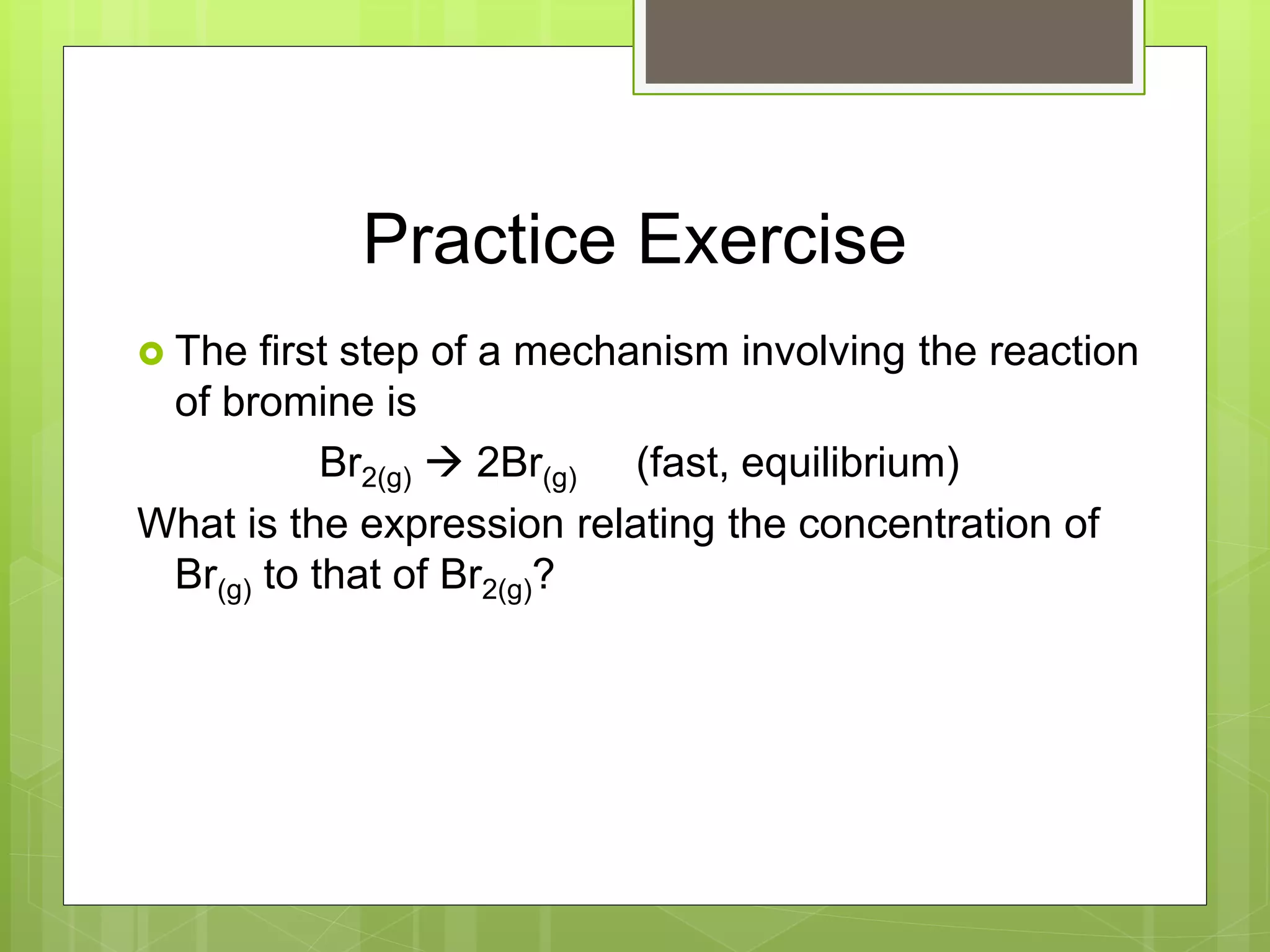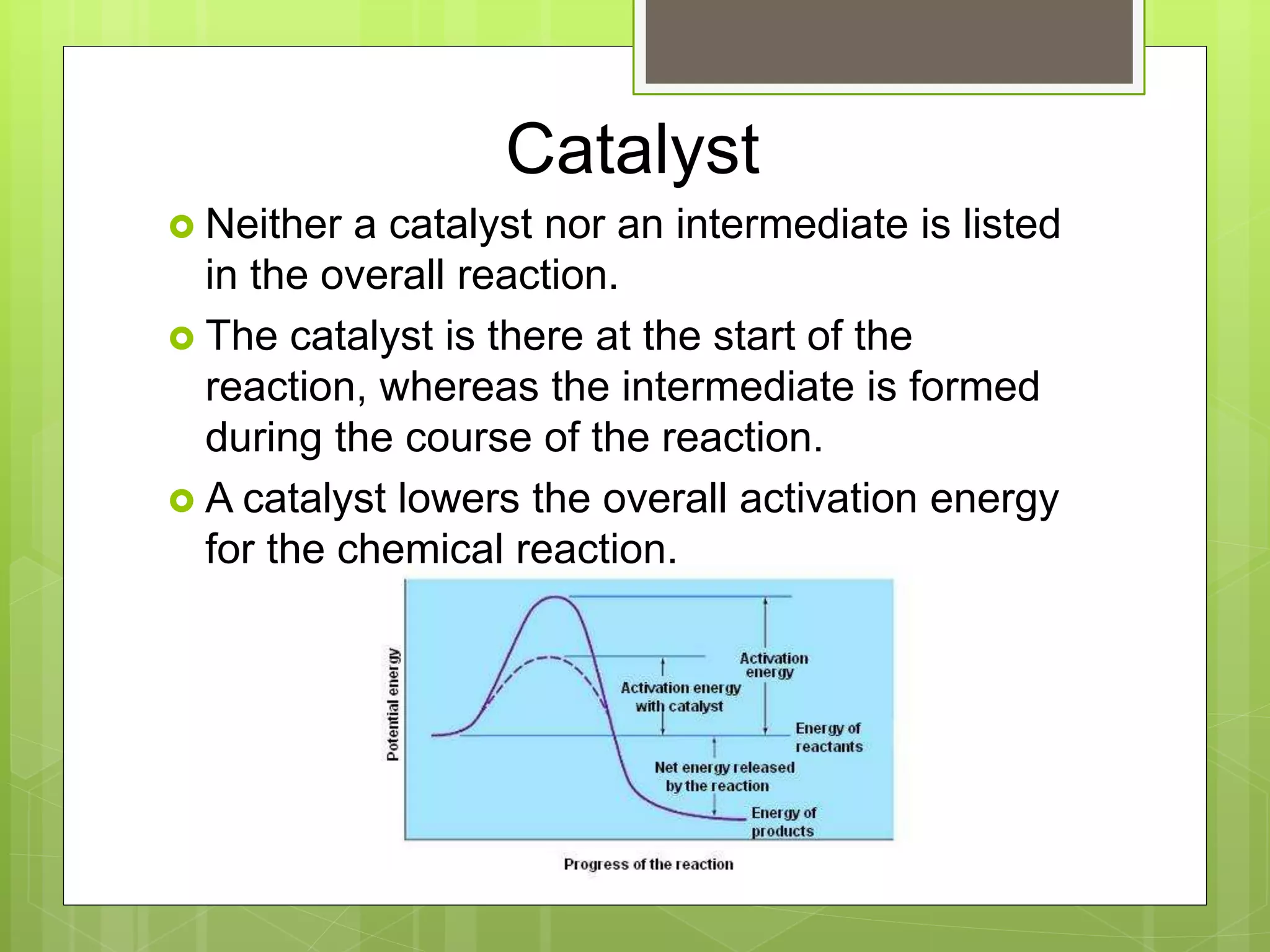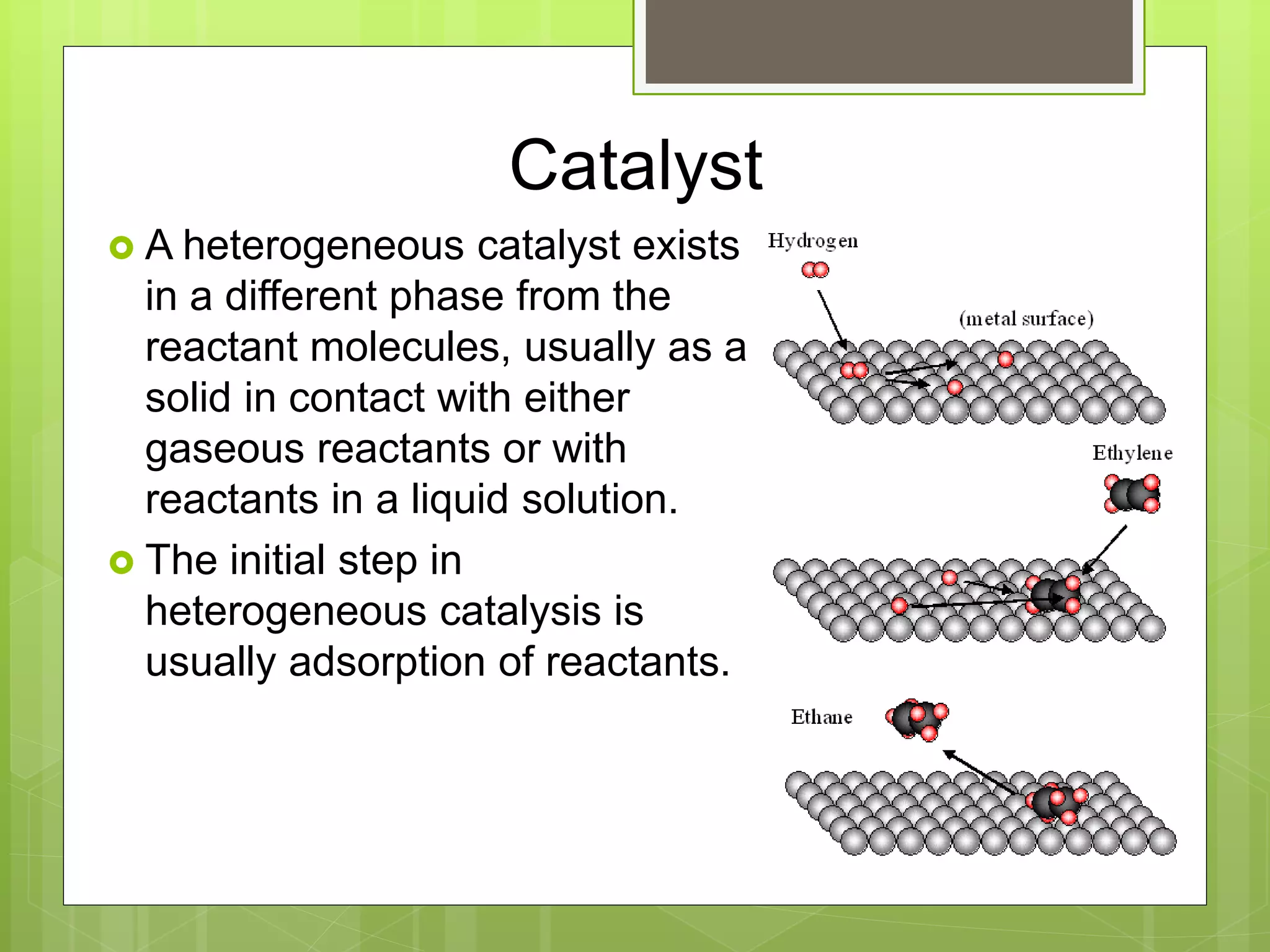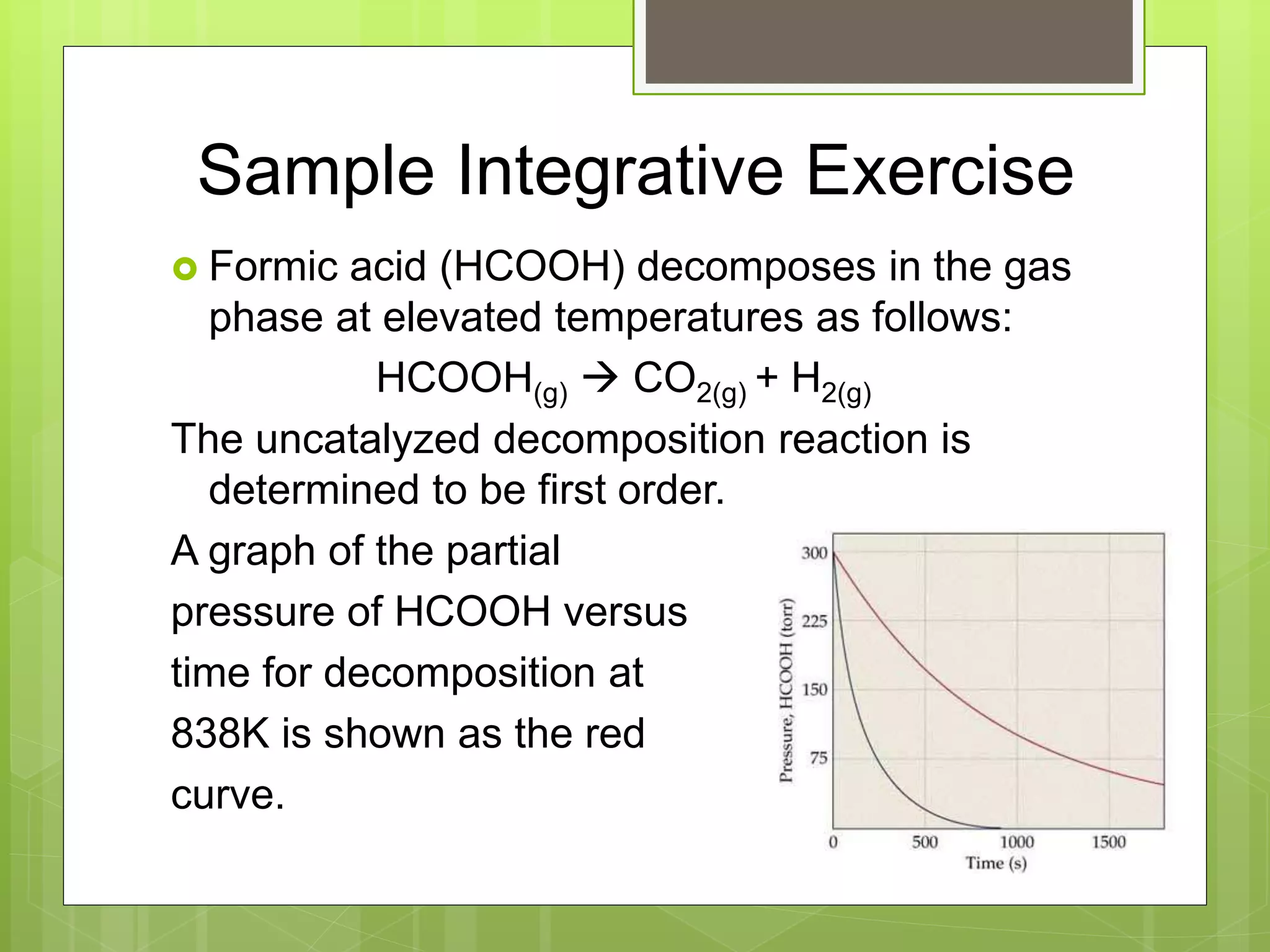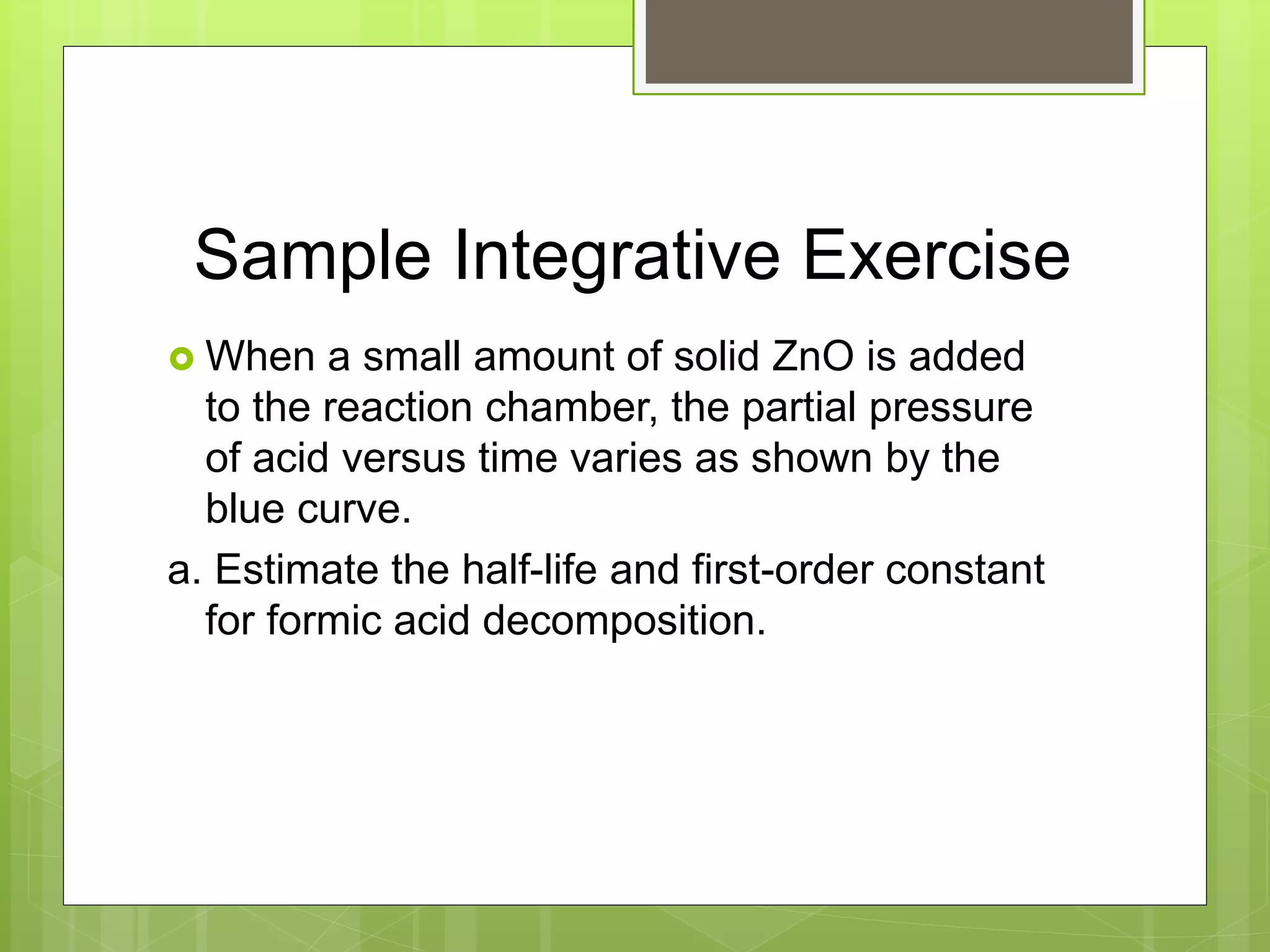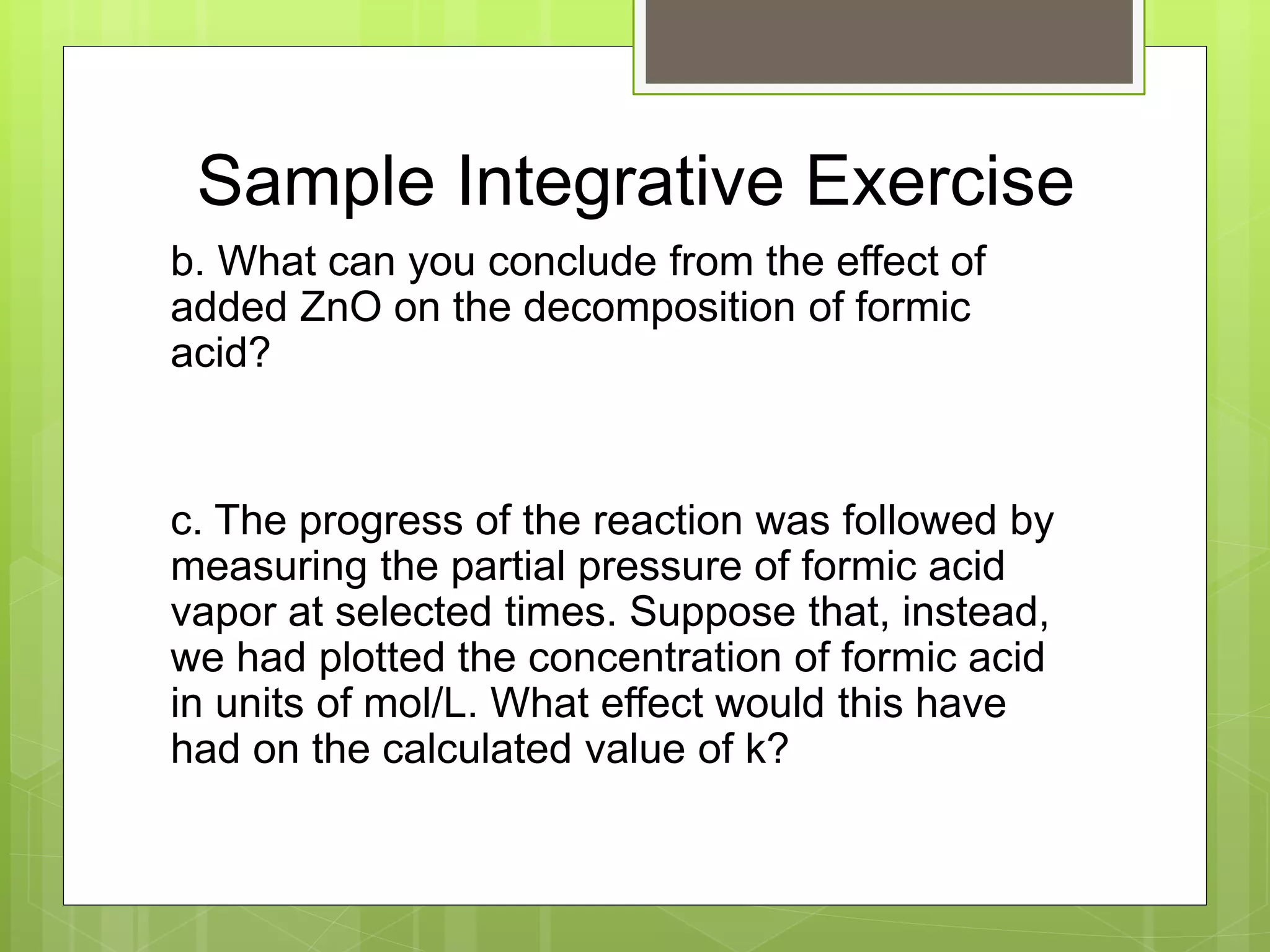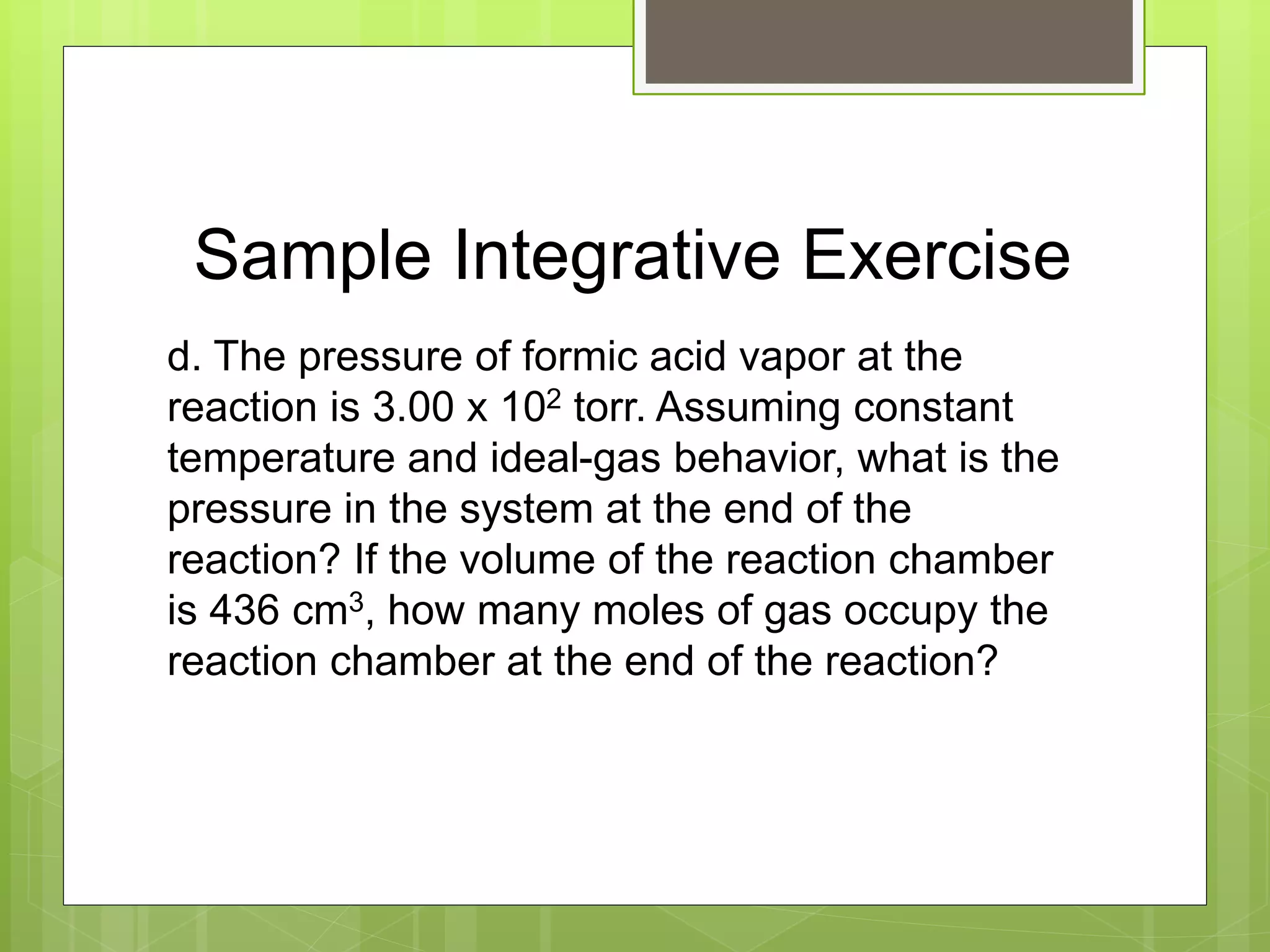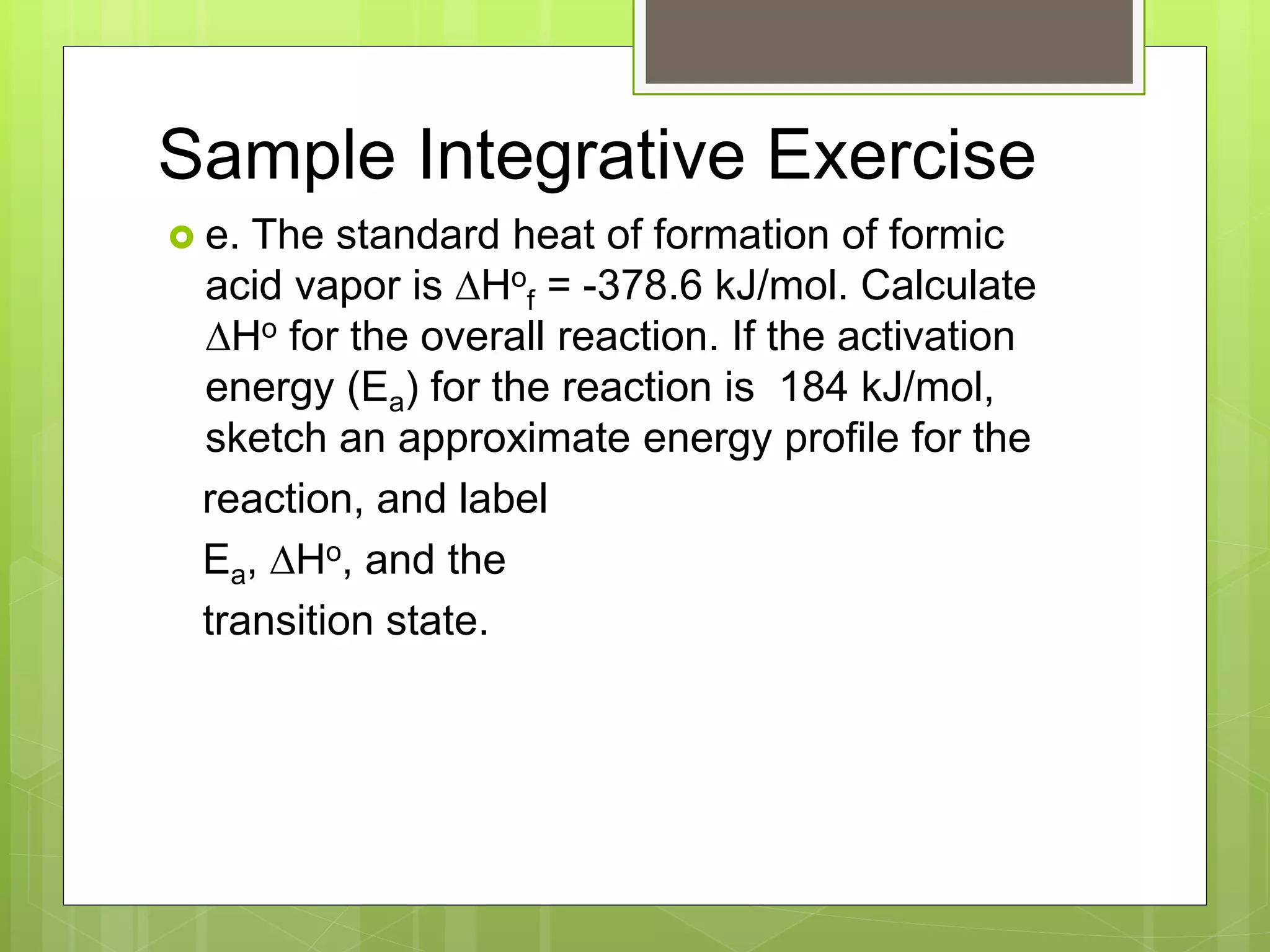This document summarizes key concepts in chemical kinetics. It discusses factors that affect reaction rates such as concentration, temperature, and catalysts. Reaction rates are expressed using rate laws and rate constants. Rate laws are determined experimentally and show how reaction rates depend on concentrations. Rates change over time and can be modeled using integrated rate laws for first and second order reactions. Reaction mechanisms involve elementary steps and may have intermediates. The activation energy required to reach the transition state affects temperature dependence of reaction rates.
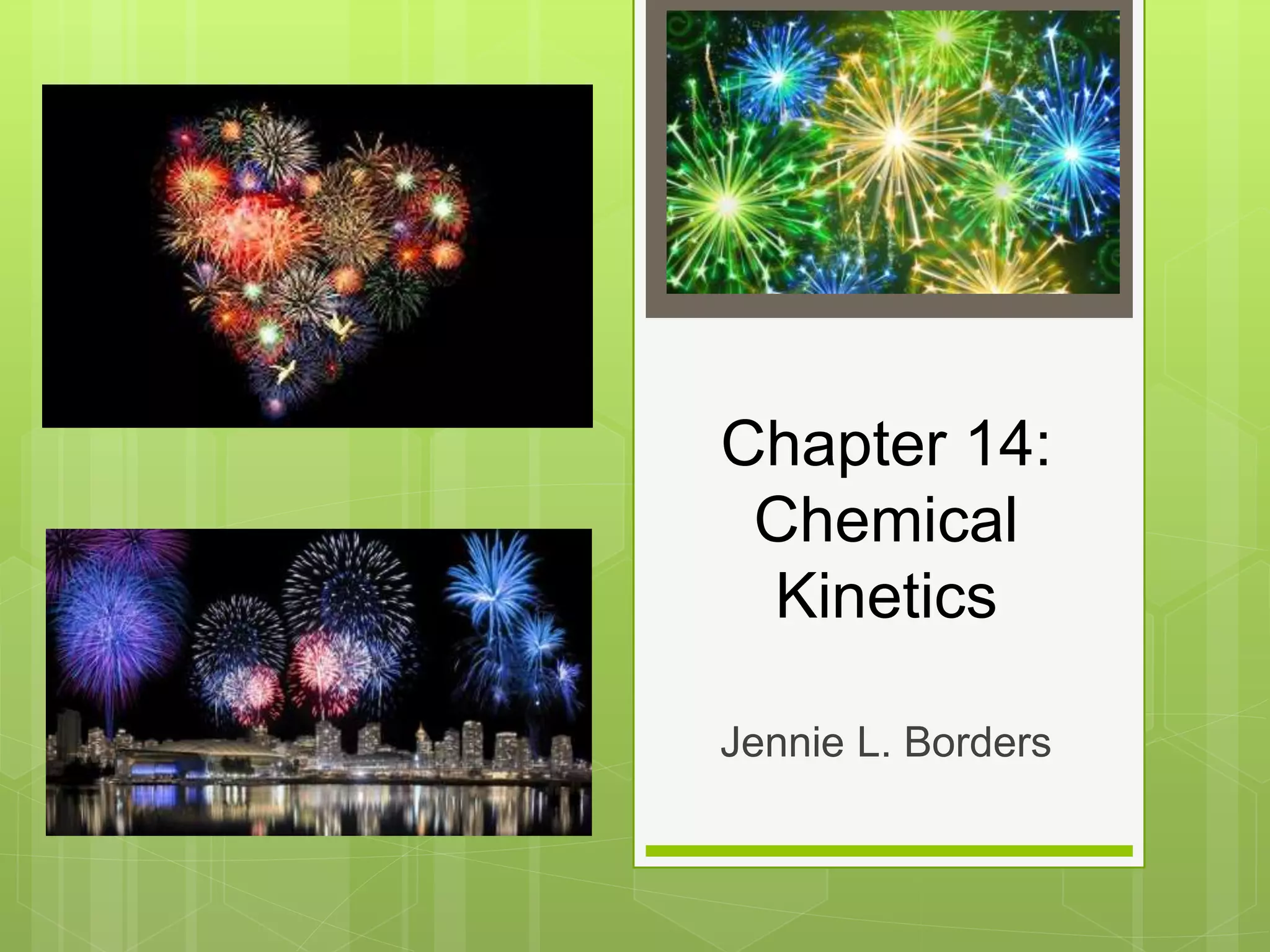
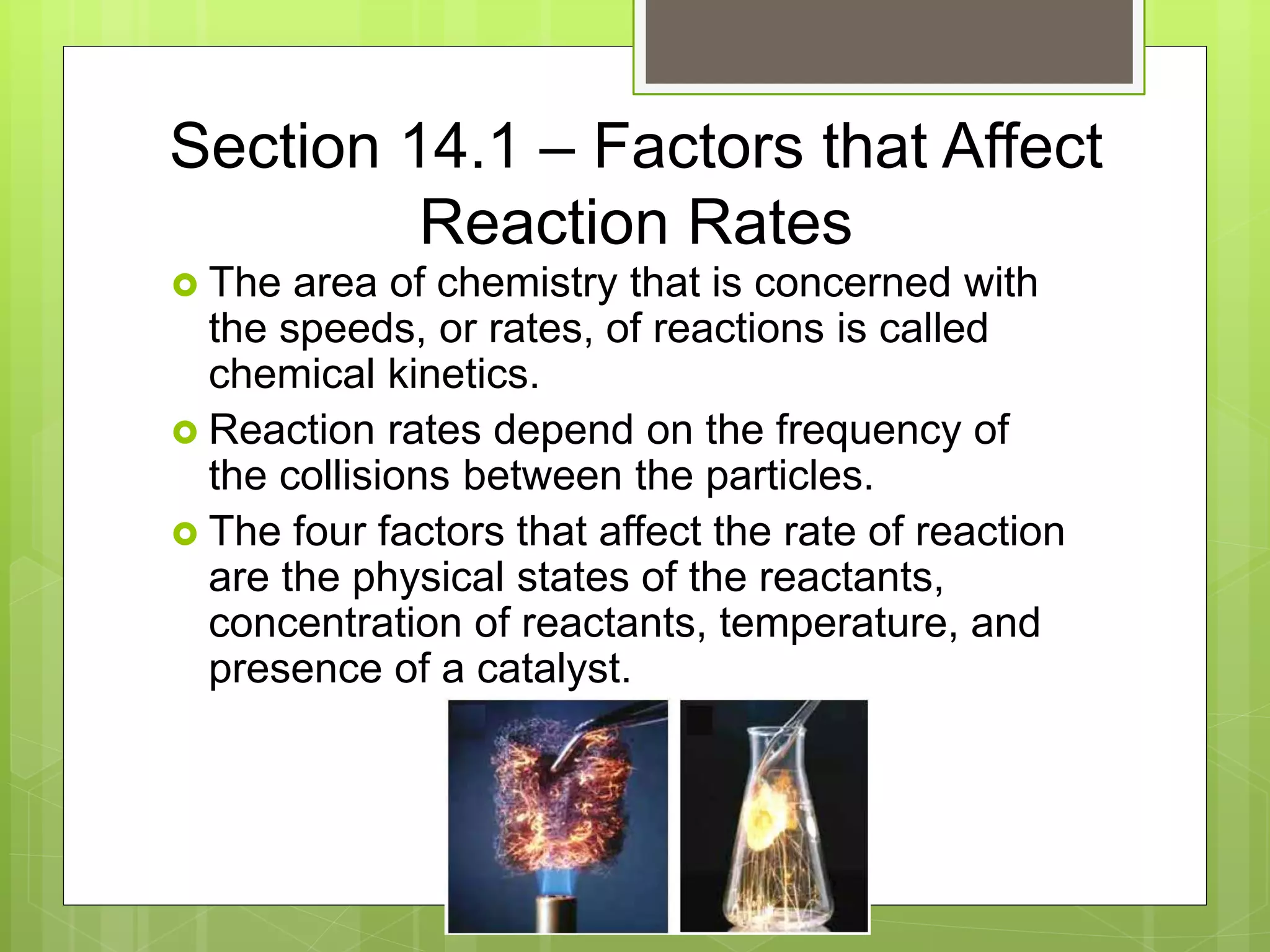
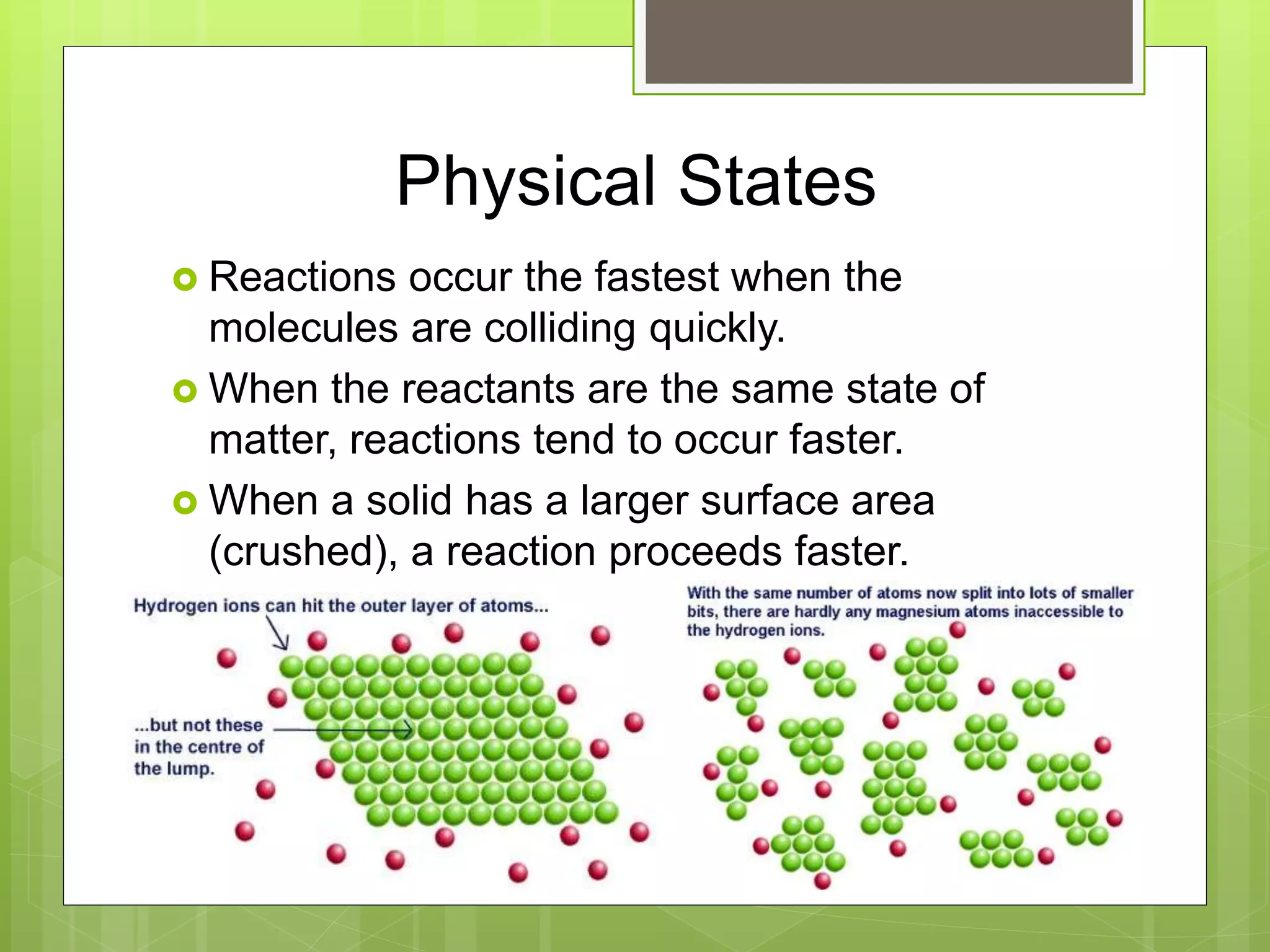
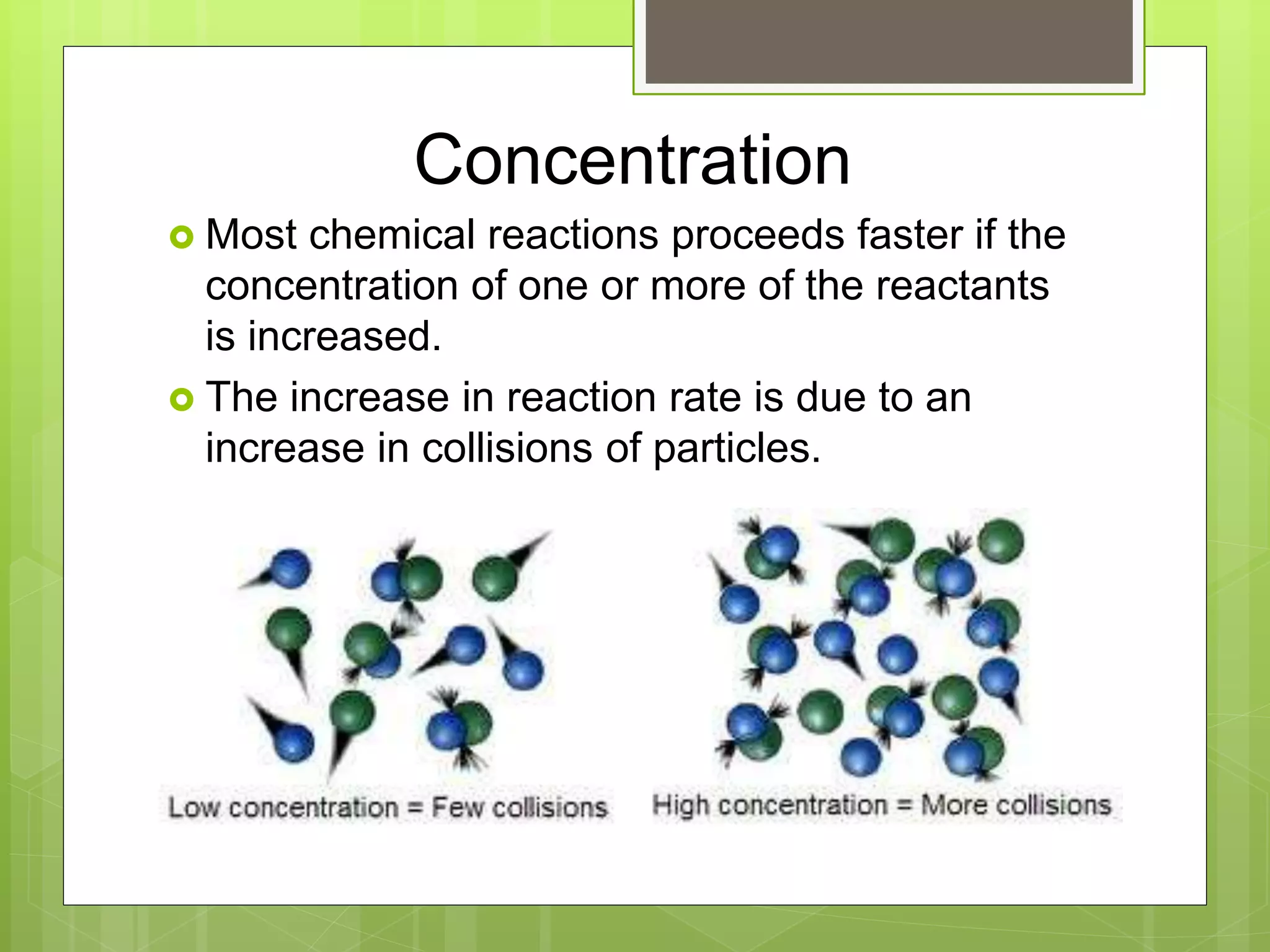
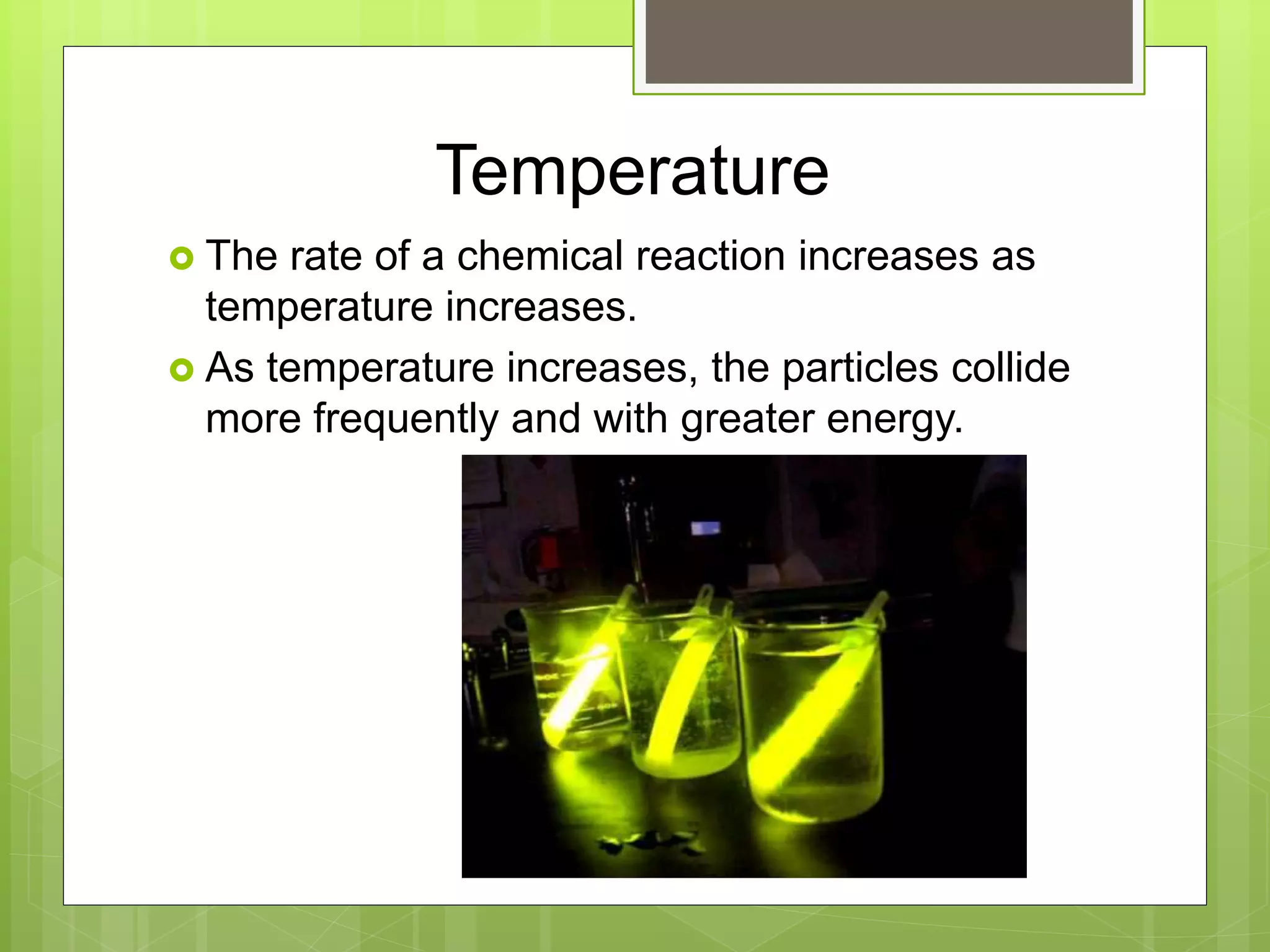
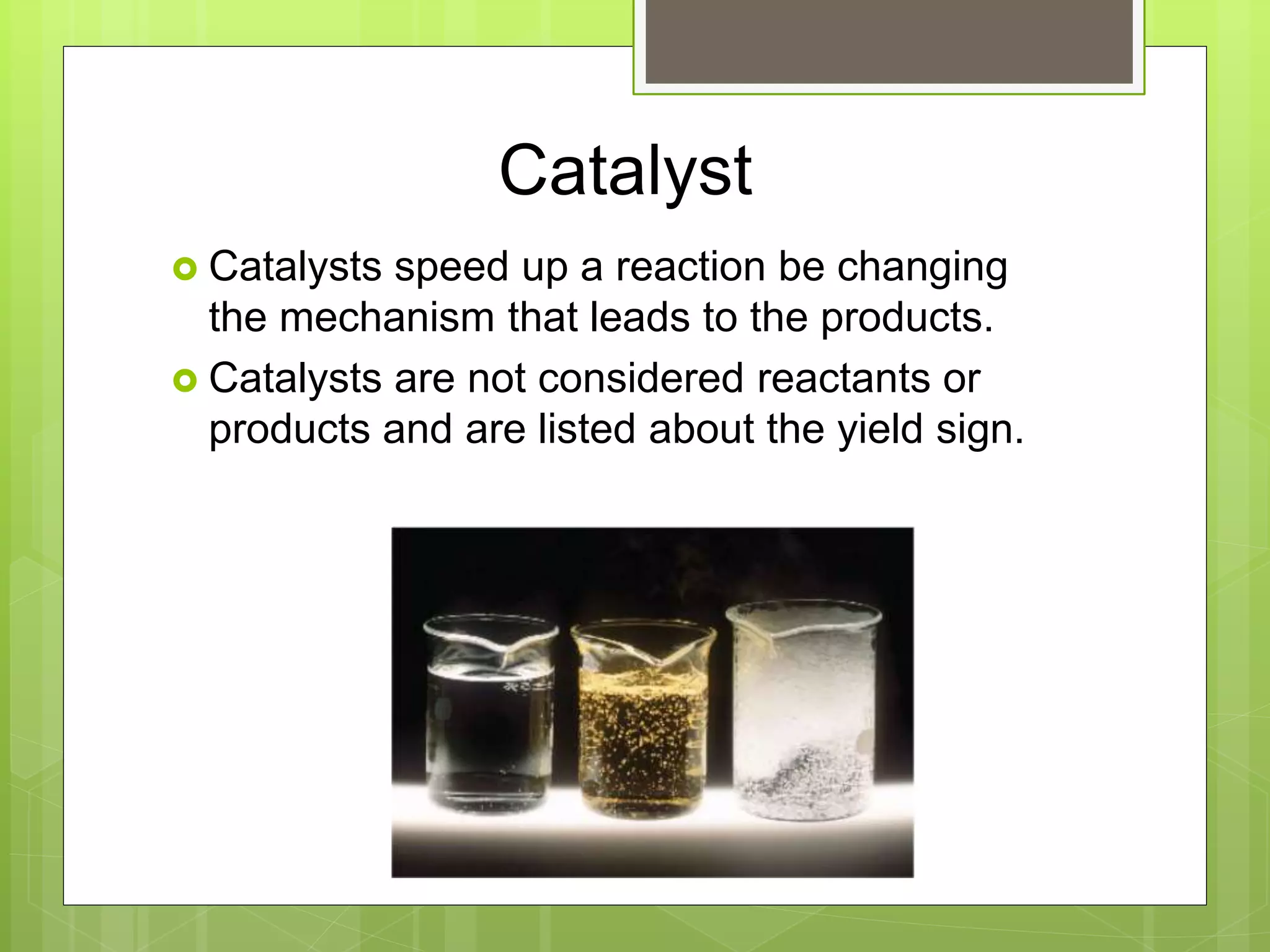
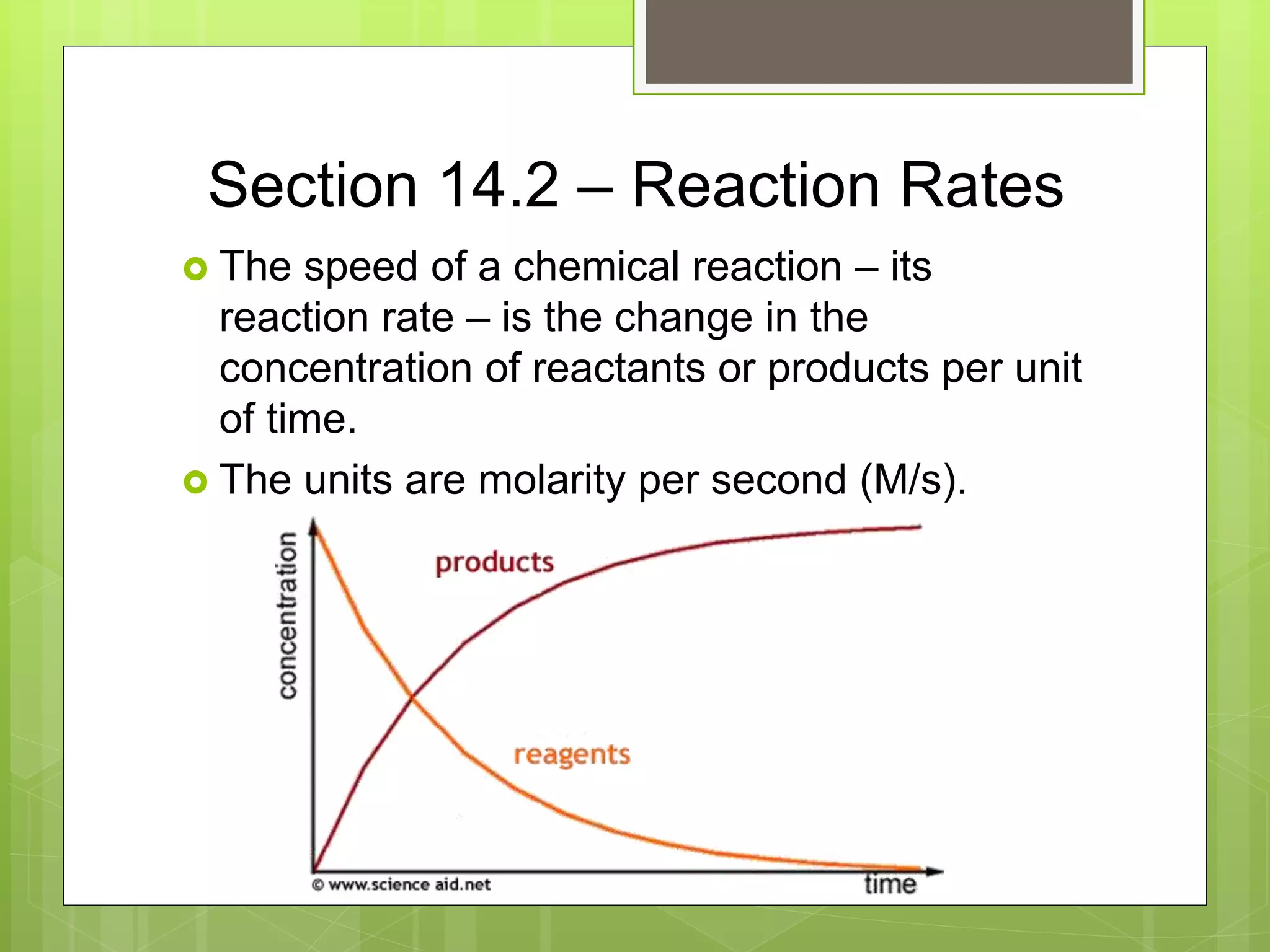
![Reaction Rates
The rate of a reaction can be expressed as either the
disappearance of the reactant or the appearance of the
product.
A B
Appearance of B = D[B]
Dt
Disappearance of A = -D[A]
Dt](https://image.slidesharecdn.com/apchemistrychapter14powerpointforwebsite-230330152000-8a9d2131/75/AP-Chemistry-Chapter-14-Powerpoint-for-website-ppt-8-2048.jpg)

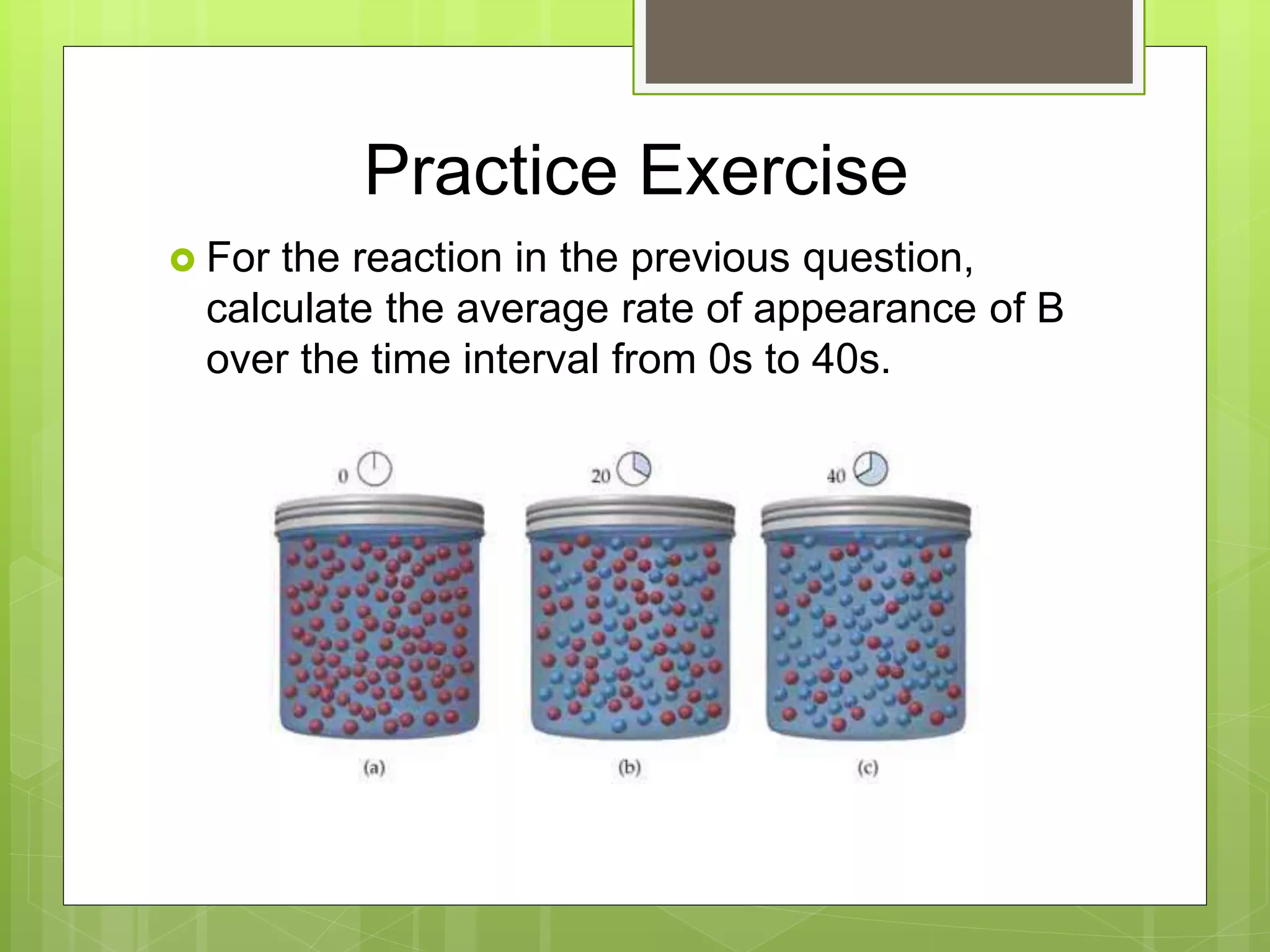
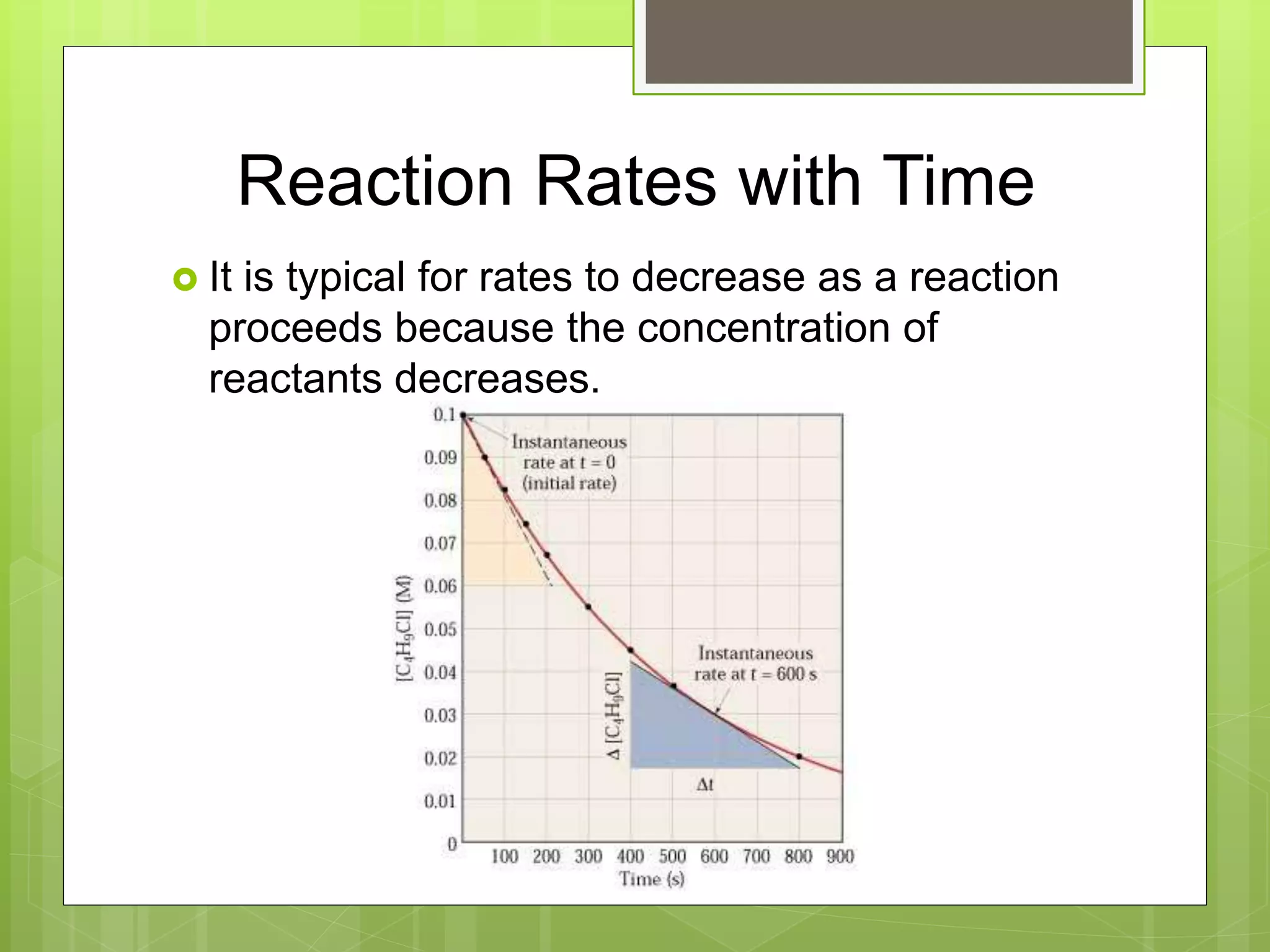
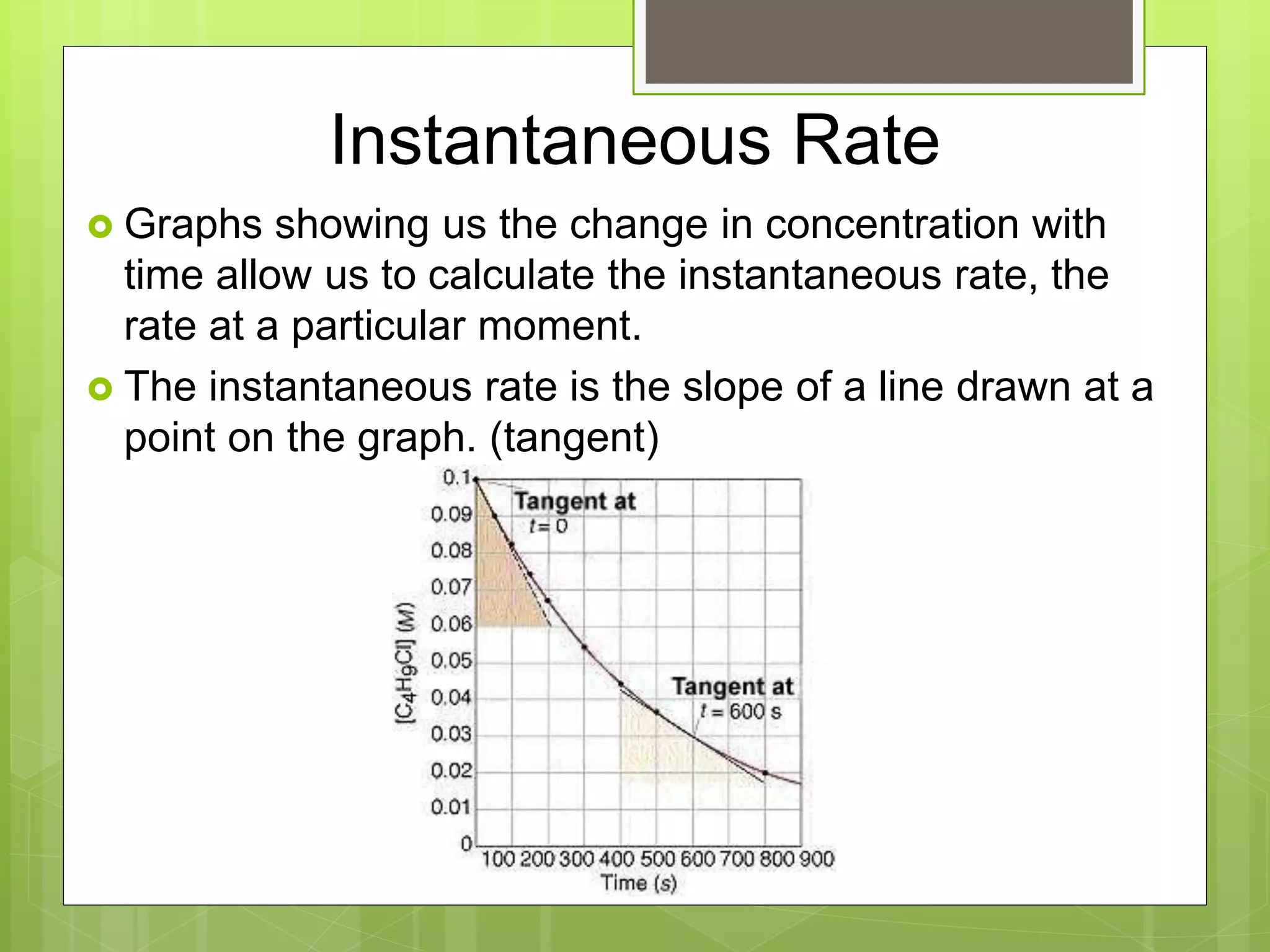
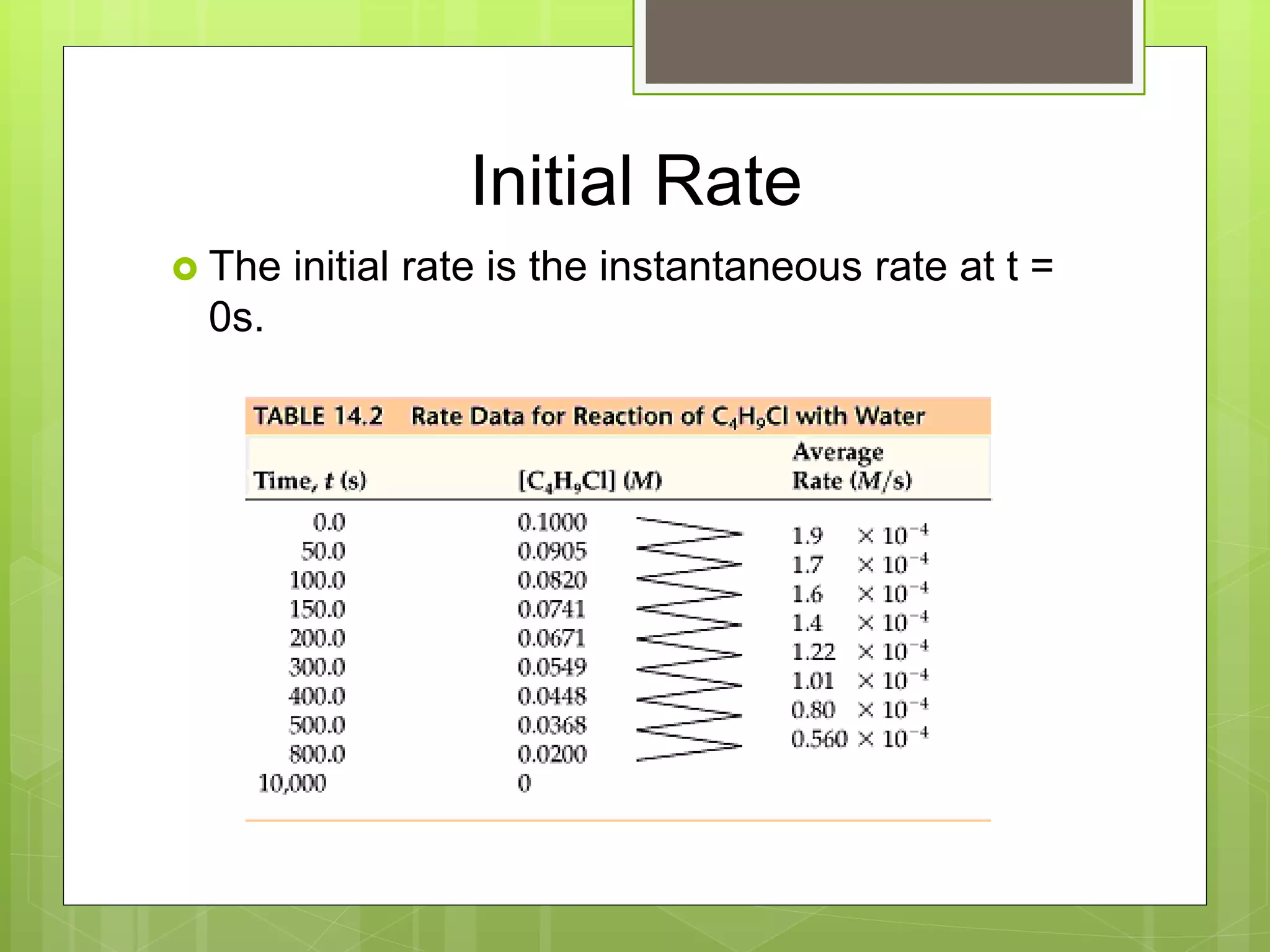
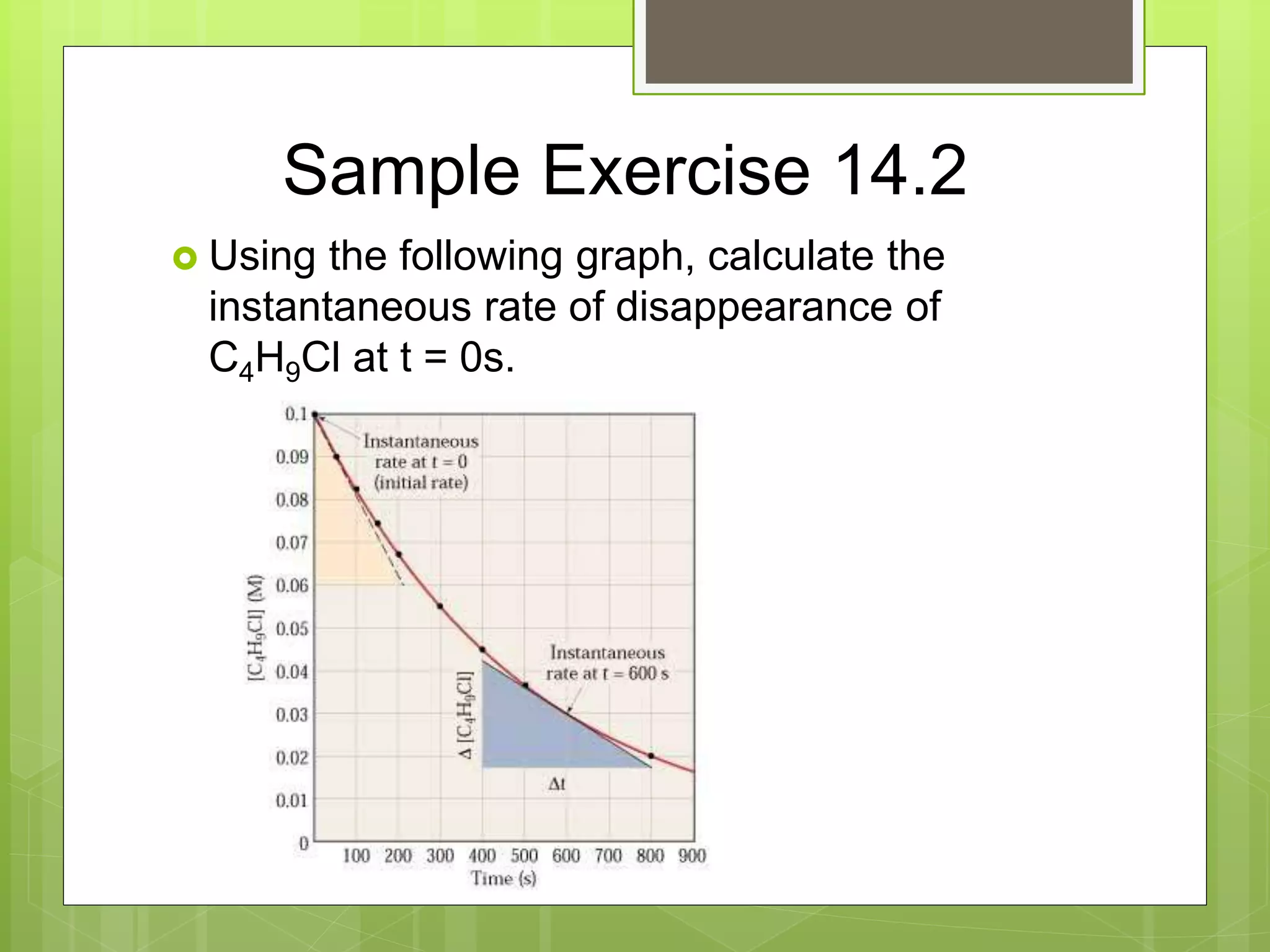
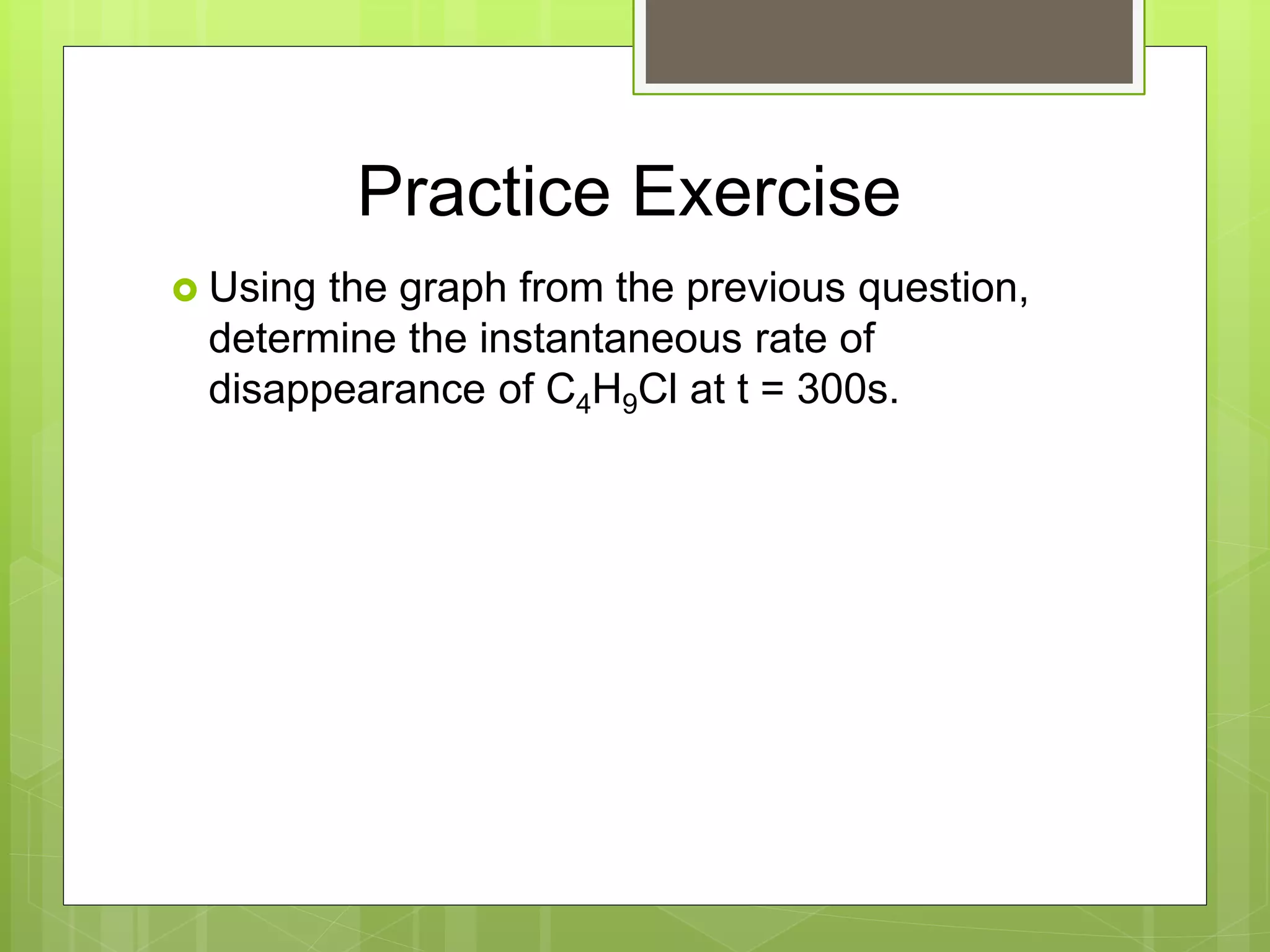
![Stoichiometry
When determining the reaction rates for a chemical
reaction, the coefficients must be used.
aA + bB cC + dD
Reaction = - 1 D[A] = -1 D[B] = 1 D[C] = 1 D[D]
Rate a Dt b Dt c Dt d Dt](https://image.slidesharecdn.com/apchemistrychapter14powerpointforwebsite-230330152000-8a9d2131/75/AP-Chemistry-Chapter-14-Powerpoint-for-website-ppt-16-2048.jpg)

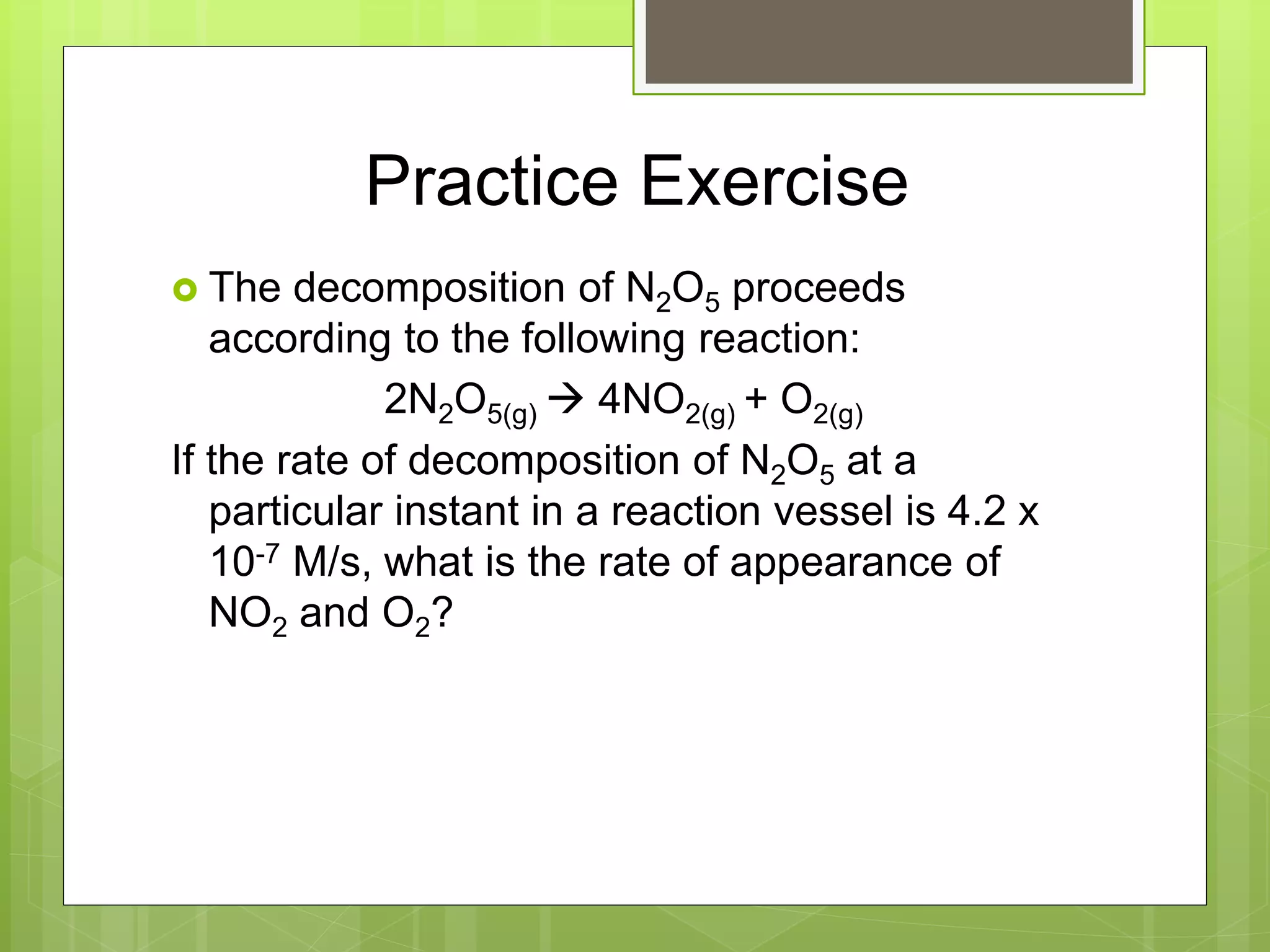
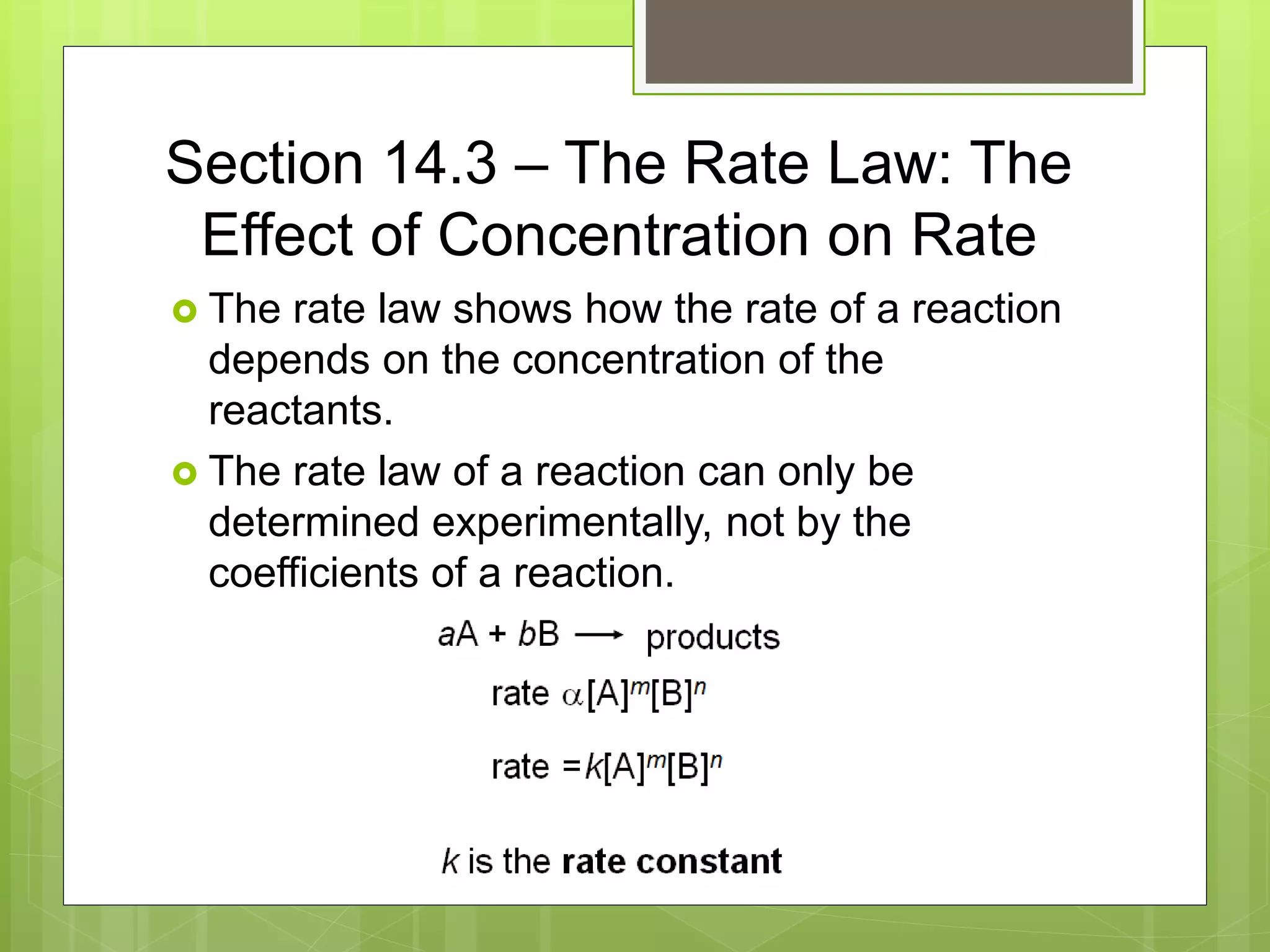
![Rate Law
The rate law is written as follows:
aA + bB cC + dD
Rate = k[A]m[B]n
k = rate constant which changes with
temperature
m and n = typically small whole numbers](https://image.slidesharecdn.com/apchemistrychapter14powerpointforwebsite-230330152000-8a9d2131/75/AP-Chemistry-Chapter-14-Powerpoint-for-website-ppt-20-2048.jpg)
![Determining Rate Law
Using the chart, we can see that the rate law
would be
Rate = k[NH4
+][NO2
-]
Since the rates change with a direct
proportion to the concentrations of both
reactants.](https://image.slidesharecdn.com/apchemistrychapter14powerpointforwebsite-230330152000-8a9d2131/75/AP-Chemistry-Chapter-14-Powerpoint-for-website-ppt-21-2048.jpg)
![Reaction Orders
The exponents m and n in a rate law are
called the reaction orders.
The overall reaction order is the sum of the
reaction orders.
Rate = k[NH4
+][NO2
-]
NH4
+ = 1st order
NO2
- = 1st order
Overall reaction order = 2nd order](https://image.slidesharecdn.com/apchemistrychapter14powerpointforwebsite-230330152000-8a9d2131/75/AP-Chemistry-Chapter-14-Powerpoint-for-website-ppt-22-2048.jpg)
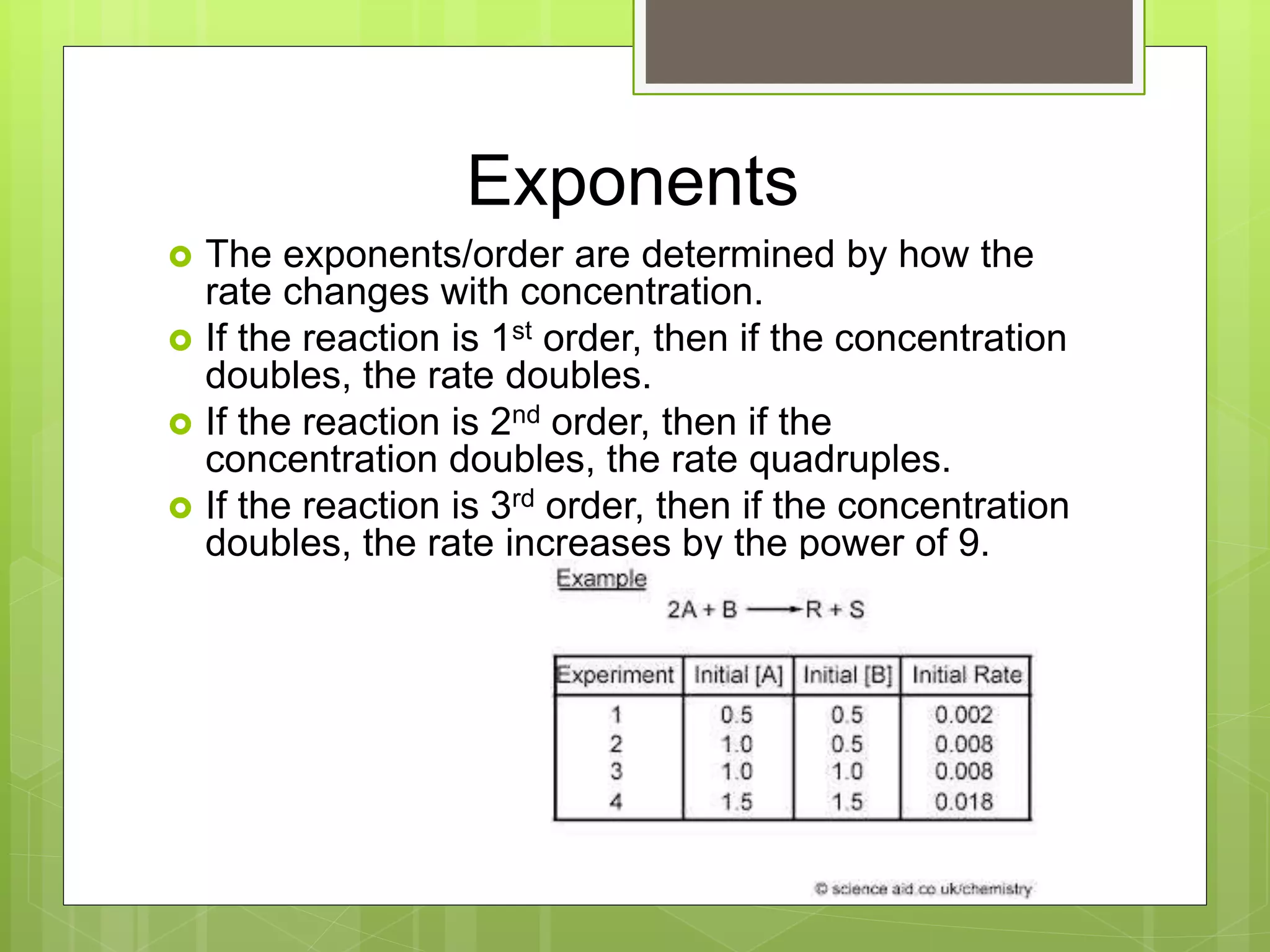
![Sample Exercise 14.4
Consider a reaction A + B C for which rate
= k[A][B]2. Each of the following boxes
represents a reaction mixture in which A is
shown as red spheres and B as purple ones.
Rank the mixtures in order of increasing rate
of reaction.](https://image.slidesharecdn.com/apchemistrychapter14powerpointforwebsite-230330152000-8a9d2131/75/AP-Chemistry-Chapter-14-Powerpoint-for-website-ppt-24-2048.jpg)
![Practice Exercise
Assuming that rate = k[A][B], rank the
previous mixtures in order of increasing rate.](https://image.slidesharecdn.com/apchemistrychapter14powerpointforwebsite-230330152000-8a9d2131/75/AP-Chemistry-Chapter-14-Powerpoint-for-website-ppt-25-2048.jpg)
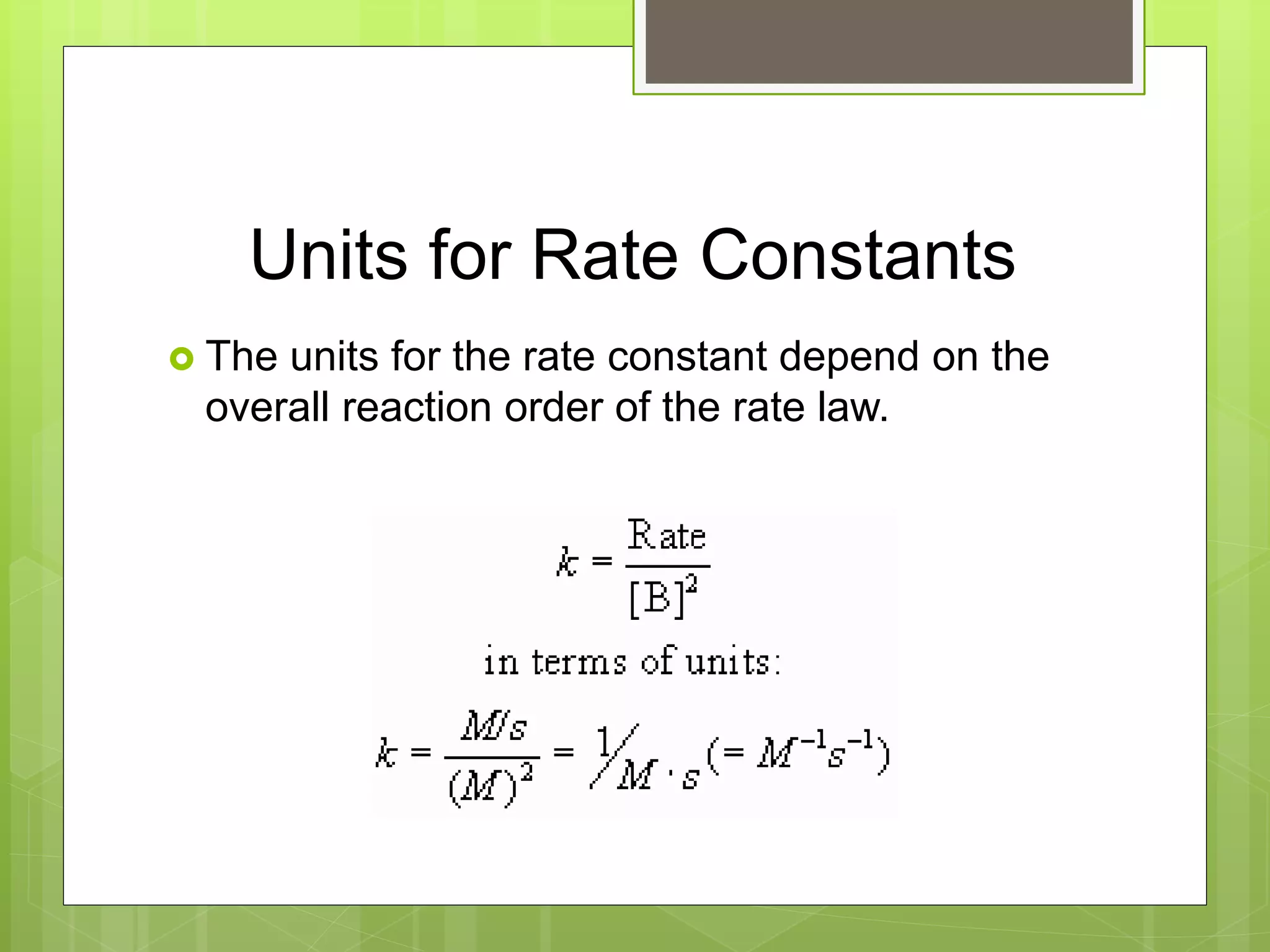
![Sample Exercise 14.5
a. What are the reaction orders for the
following reactions?
2N2O5(g) 4NO2(g) + +O2(g)
Rate = k[N2O5]
CHCl3(g) + Cl2(g) CCl4(g) + HCl(g)
Rate = k[CHCl3][Cl2]1/2](https://image.slidesharecdn.com/apchemistrychapter14powerpointforwebsite-230330152000-8a9d2131/75/AP-Chemistry-Chapter-14-Powerpoint-for-website-ppt-27-2048.jpg)

![Practice Exercise
a. What is the reaction order of the reactant H2
in the following equation?
H2(g) + I2(g) 2HI(g)
Rate = k[H2][I2]
b. What are the units of the rate constant for the
equation?](https://image.slidesharecdn.com/apchemistrychapter14powerpointforwebsite-230330152000-8a9d2131/75/AP-Chemistry-Chapter-14-Powerpoint-for-website-ppt-29-2048.jpg)
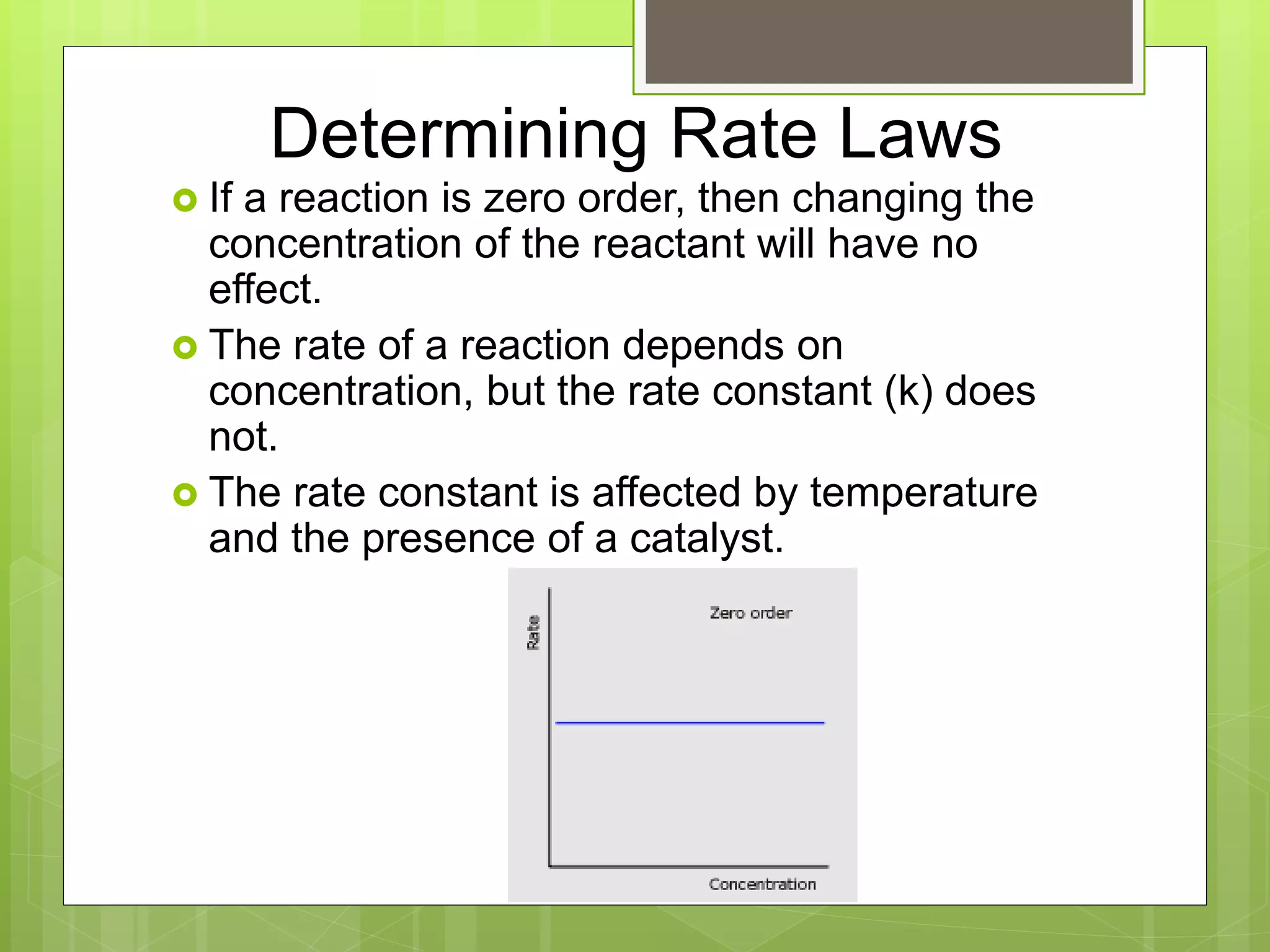

![Sample Exercise 14.6 con’t
a. Using the data, determine the rate law for
the reaction.
b. Determine the rate constant.
c. Determine the rate of the reaction when [A] =
0.050M and [B] = 0.100M.](https://image.slidesharecdn.com/apchemistrychapter14powerpointforwebsite-230330152000-8a9d2131/75/AP-Chemistry-Chapter-14-Powerpoint-for-website-ppt-32-2048.jpg)
![Practice Exercise
The following data was measured for the
reaction of nitric oxide with hydrogen:
2NO(g) + 2H2(g) N2(g) + 2H2O(g)
Experiment
Number
[NO]
(M)
[H2]
(M)
Initial Rate (M/s)
1 0.1 0.1 1.23 x 10-3
2 0.1 0.2 2.46 x 10-3
3 0.2 0.1 4.62 x 10-3](https://image.slidesharecdn.com/apchemistrychapter14powerpointforwebsite-230330152000-8a9d2131/75/AP-Chemistry-Chapter-14-Powerpoint-for-website-ppt-33-2048.jpg)
![Practice Exercise con’t
a. Determine the rate law for this reaction.
a. Calculate the rate constant.
a. Calculate the rate when [NO] = 0.050M and
[H2] = 0.150M.](https://image.slidesharecdn.com/apchemistrychapter14powerpointforwebsite-230330152000-8a9d2131/75/AP-Chemistry-Chapter-14-Powerpoint-for-website-ppt-34-2048.jpg)
![Section 14.4 – The Change of
Concentration with Time
A first order reaction is one whose rate
depends on the concentration of a single
reactant to the first power.
Differential Rate Law Rate = k[A]
Integrated Rate Law ln[A]t = -kt + ln[A]0
You can use this equation to solve for
concentration or time.](https://image.slidesharecdn.com/apchemistrychapter14powerpointforwebsite-230330152000-8a9d2131/75/AP-Chemistry-Chapter-14-Powerpoint-for-website-ppt-35-2048.jpg)
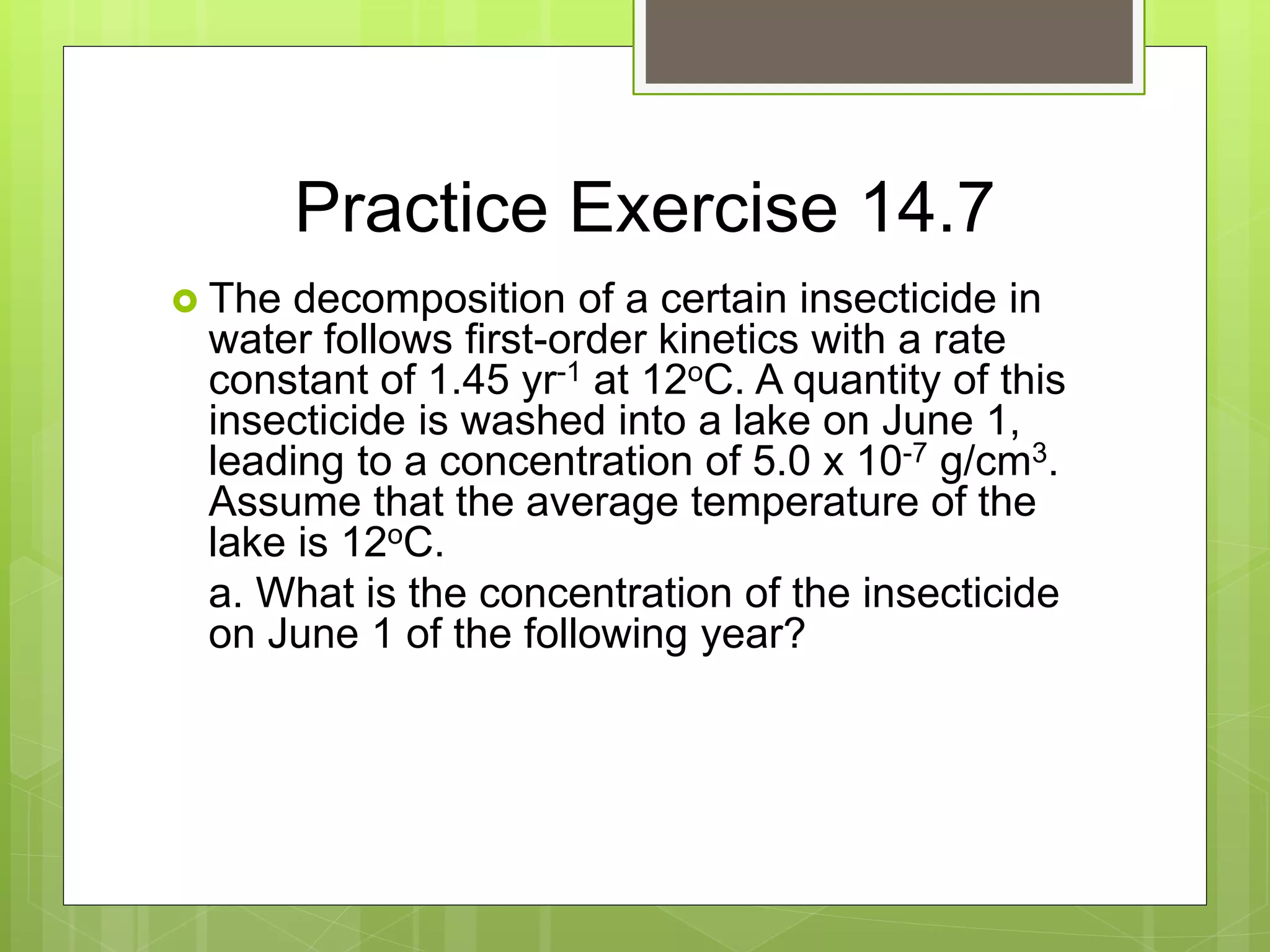
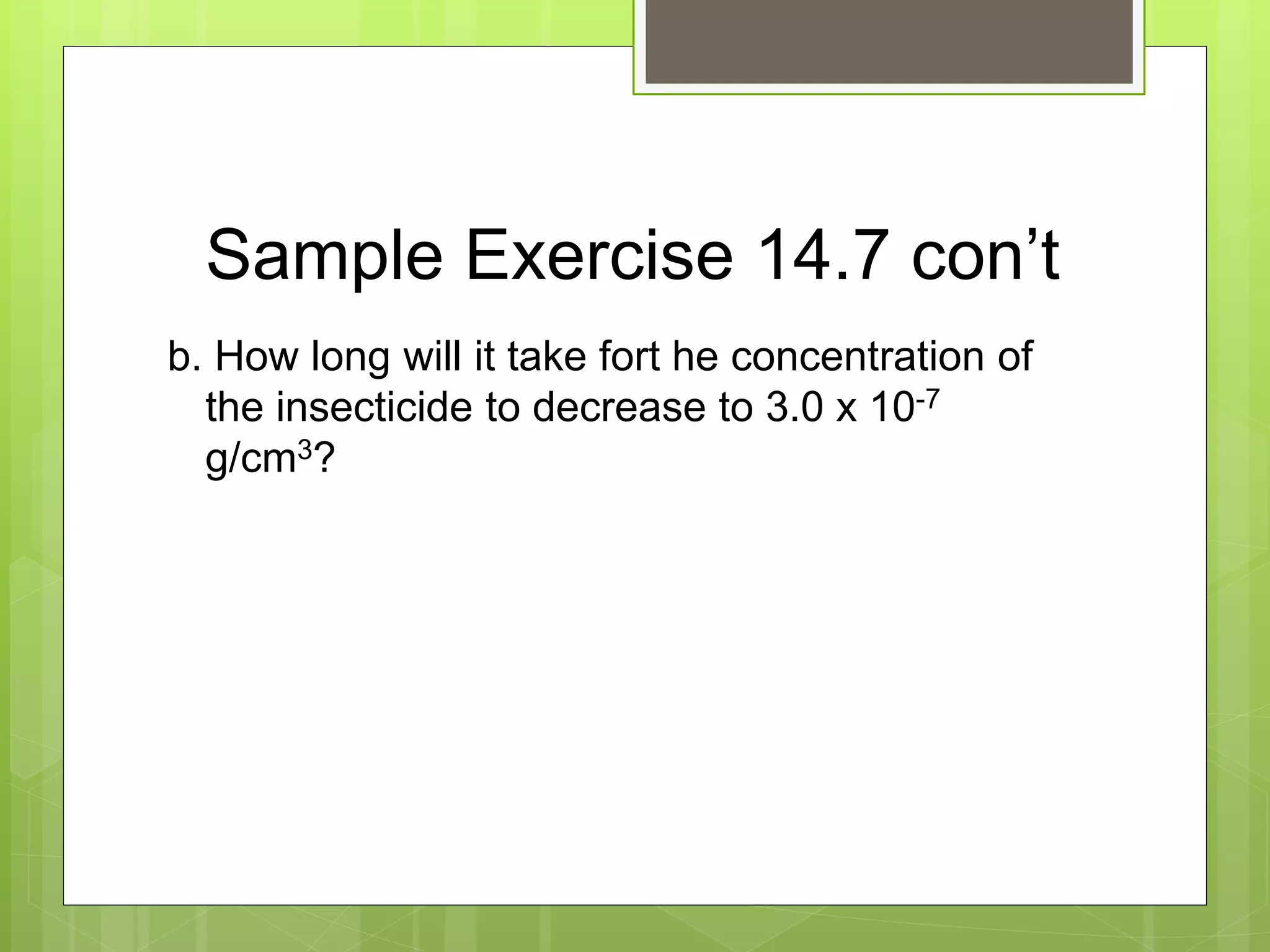
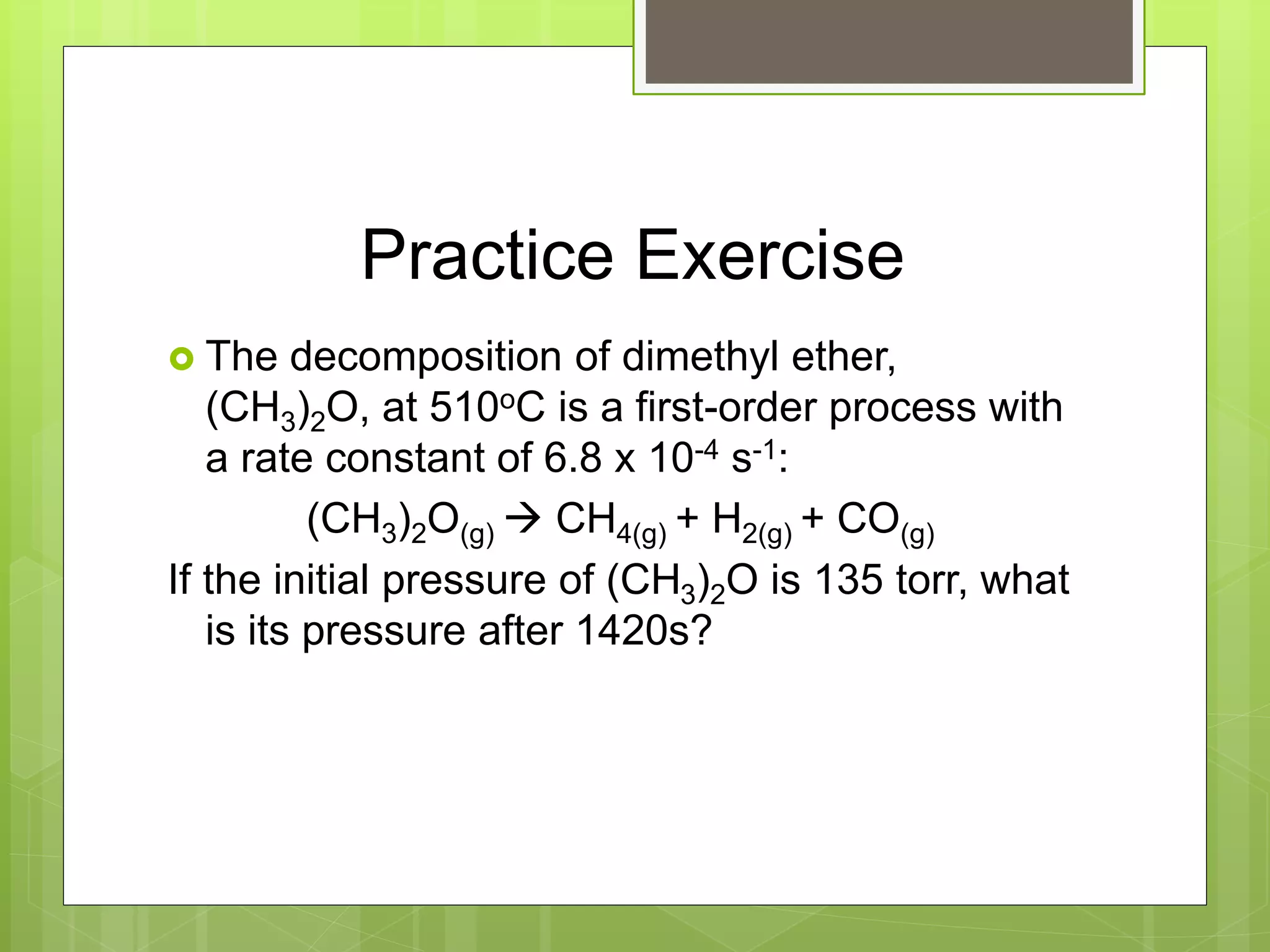
![Reaction Rate Graphs
For a 1st order reaction, a graph of ln[A]t vs.
time will give a straight line.
ln[A]t = -kt + ln[A]0
y = mx + b](https://image.slidesharecdn.com/apchemistrychapter14powerpointforwebsite-230330152000-8a9d2131/75/AP-Chemistry-Chapter-14-Powerpoint-for-website-ppt-39-2048.jpg)
![Second Order Rates
A second order reaction is one whose rate
depends on the reactant concentration to the
2nd power or 2 reactants to the 1st power.
Differential Rate Law Rate = k[A]2
Integrated Rate Law 1/[A]t = kt + 1/[A]0
y = mx + b](https://image.slidesharecdn.com/apchemistrychapter14powerpointforwebsite-230330152000-8a9d2131/75/AP-Chemistry-Chapter-14-Powerpoint-for-website-ppt-40-2048.jpg)
![Reaction Rate Graphs
For a second order reaction, a graph of 1/[A]t
vs. time gives a straight line.](https://image.slidesharecdn.com/apchemistrychapter14powerpointforwebsite-230330152000-8a9d2131/75/AP-Chemistry-Chapter-14-Powerpoint-for-website-ppt-41-2048.jpg)
![Sample Exercise 14.8
The following data was obtained fort he gas-
phase decomposition of nitrogen dioxide at
300oC, NO2(g) NO(g) + ½ O2(g):
Is the reaction first or second order in NO2?
Time (s) [NO2] (M)
0 0.01
50 0.00787
100 0.00649
200 0.00481
300 0.0038](https://image.slidesharecdn.com/apchemistrychapter14powerpointforwebsite-230330152000-8a9d2131/75/AP-Chemistry-Chapter-14-Powerpoint-for-website-ppt-42-2048.jpg)
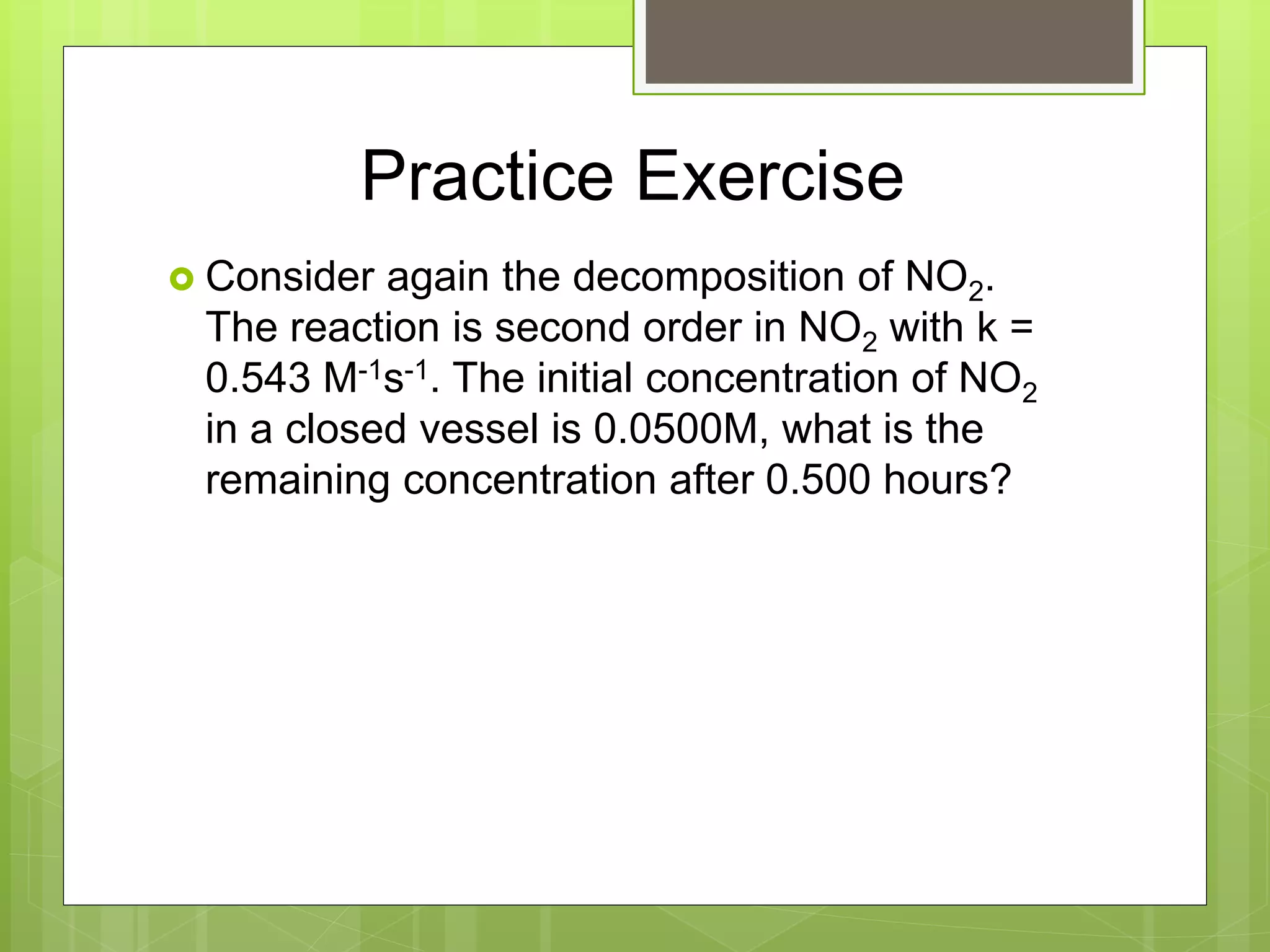
![Half-Life
The half-life of a reaction, t1/2, is the time
required for the concentration of a reactant to
reach one-half of its initial value, [A]t1/2 = ½
[A]0.
A fast reaction will have a short half-life.
Half-life for a 1st order reaction.
t1/2 = 0.693/k](https://image.slidesharecdn.com/apchemistrychapter14powerpointforwebsite-230330152000-8a9d2131/75/AP-Chemistry-Chapter-14-Powerpoint-for-website-ppt-44-2048.jpg)
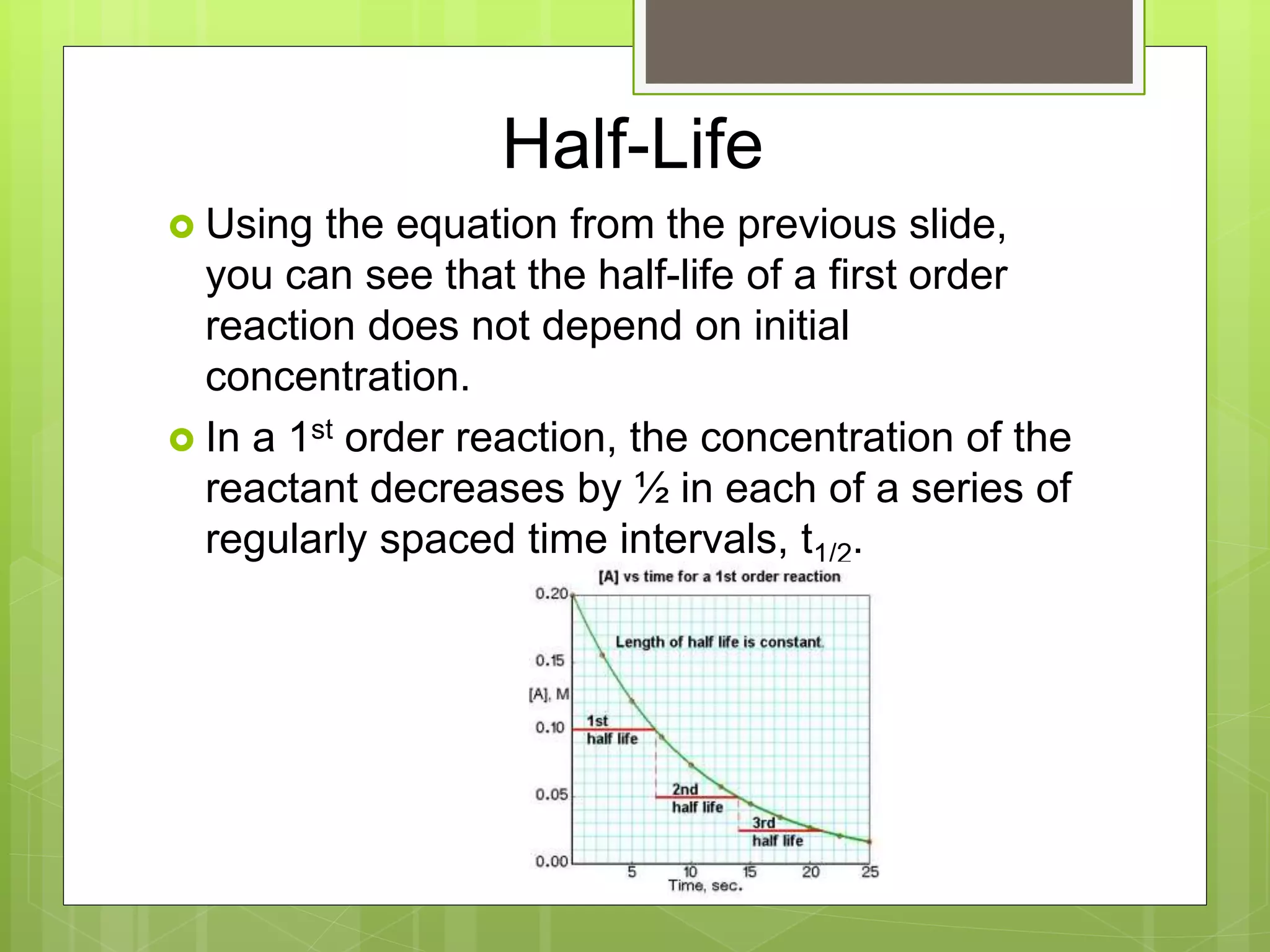
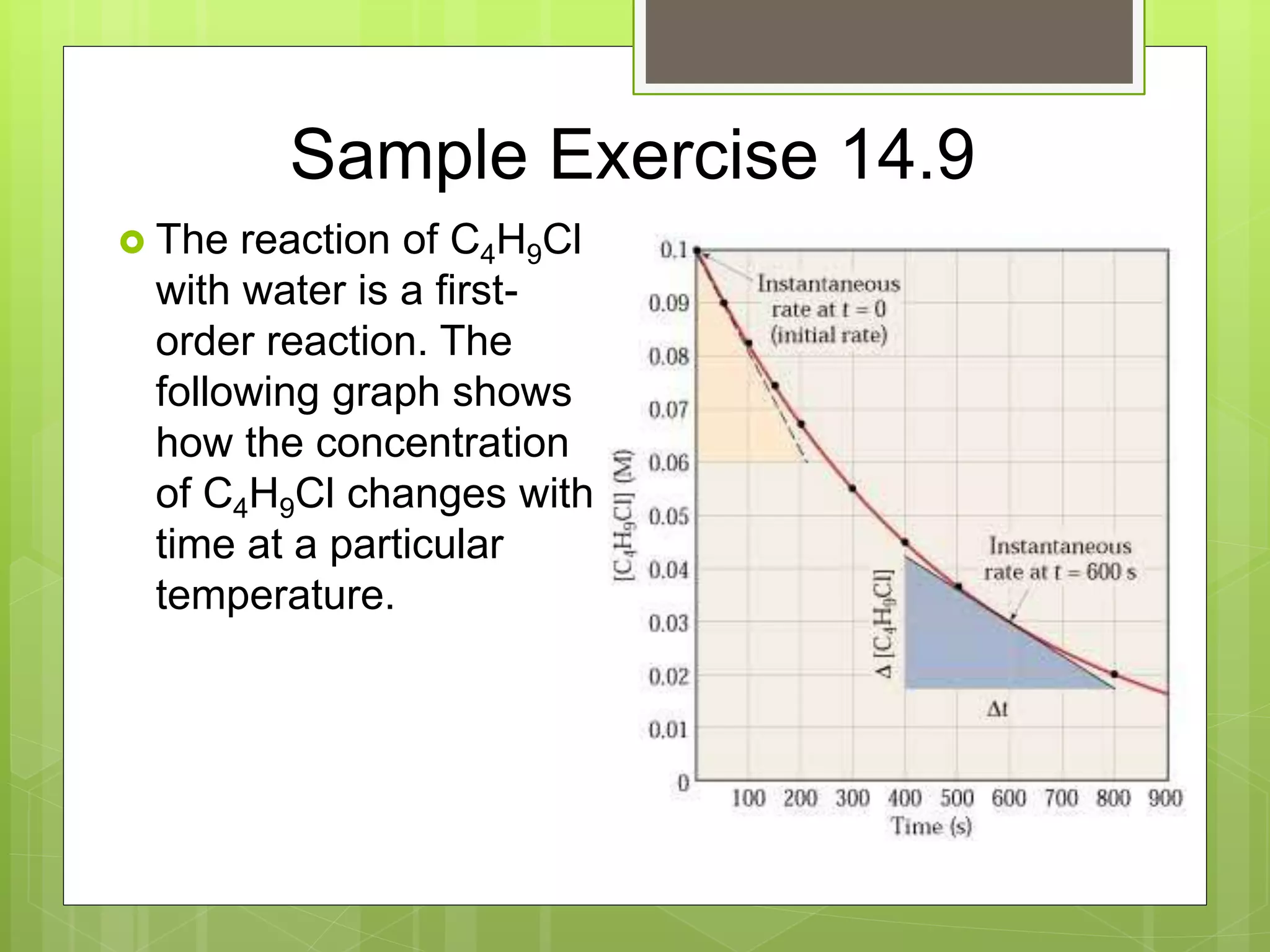
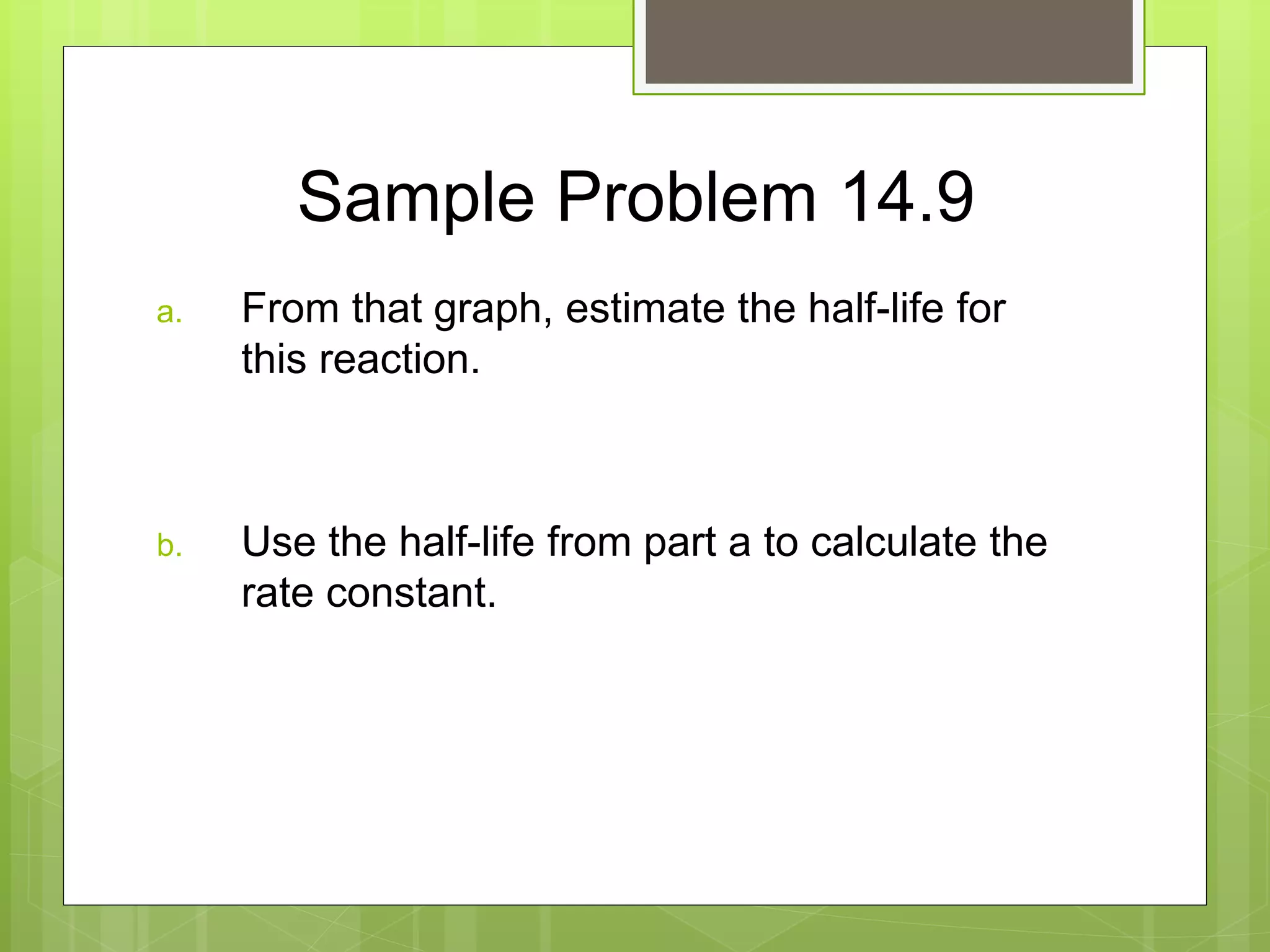
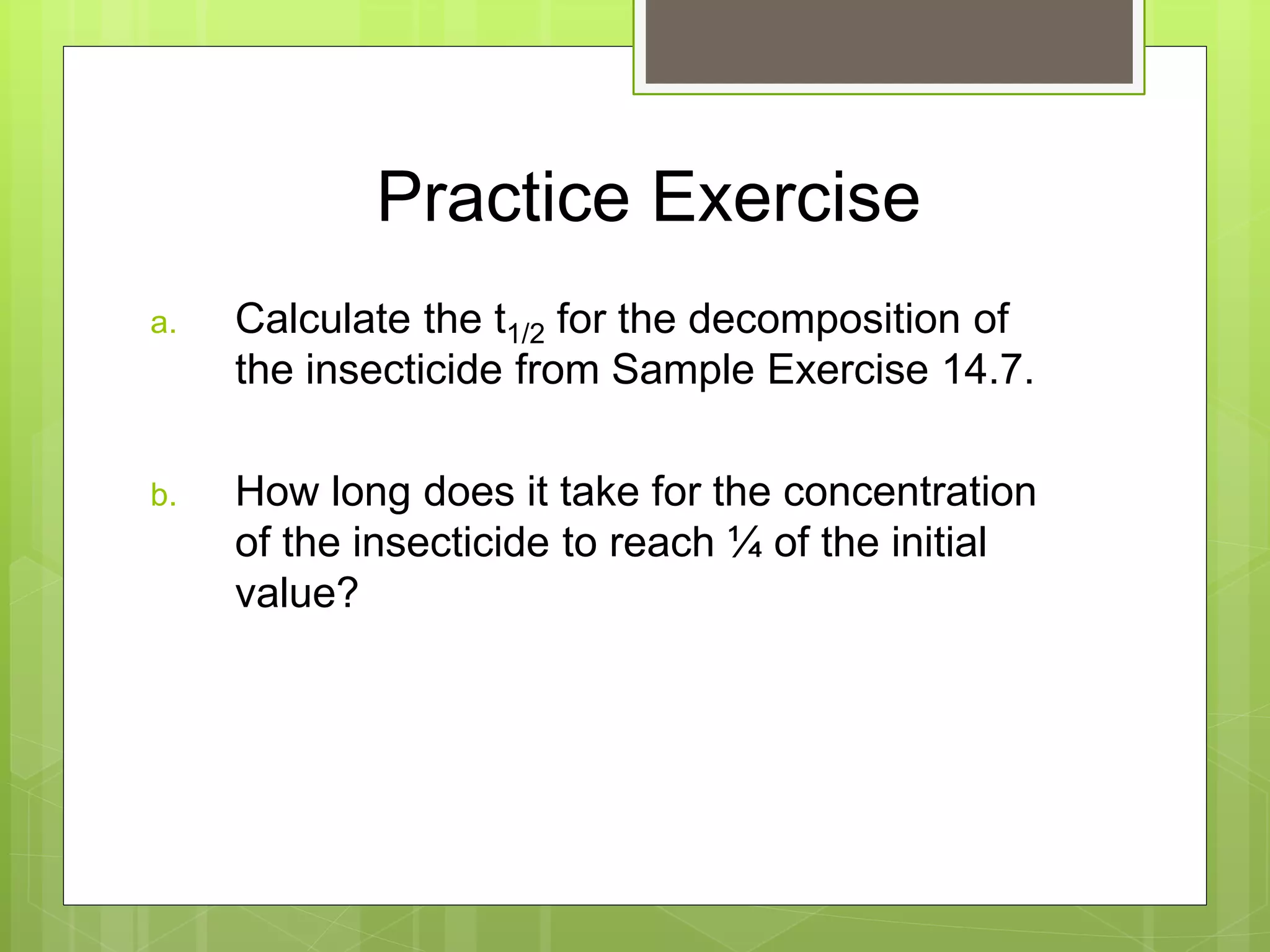
![Half-life for 2nd Order
The half-life of a 2nd order reaction does
depend on initial concentration.
t1/2 = 1/k[A]0
The lower the initial concentration, the larger the
half-life.](https://image.slidesharecdn.com/apchemistrychapter14powerpointforwebsite-230330152000-8a9d2131/75/AP-Chemistry-Chapter-14-Powerpoint-for-website-ppt-49-2048.jpg)
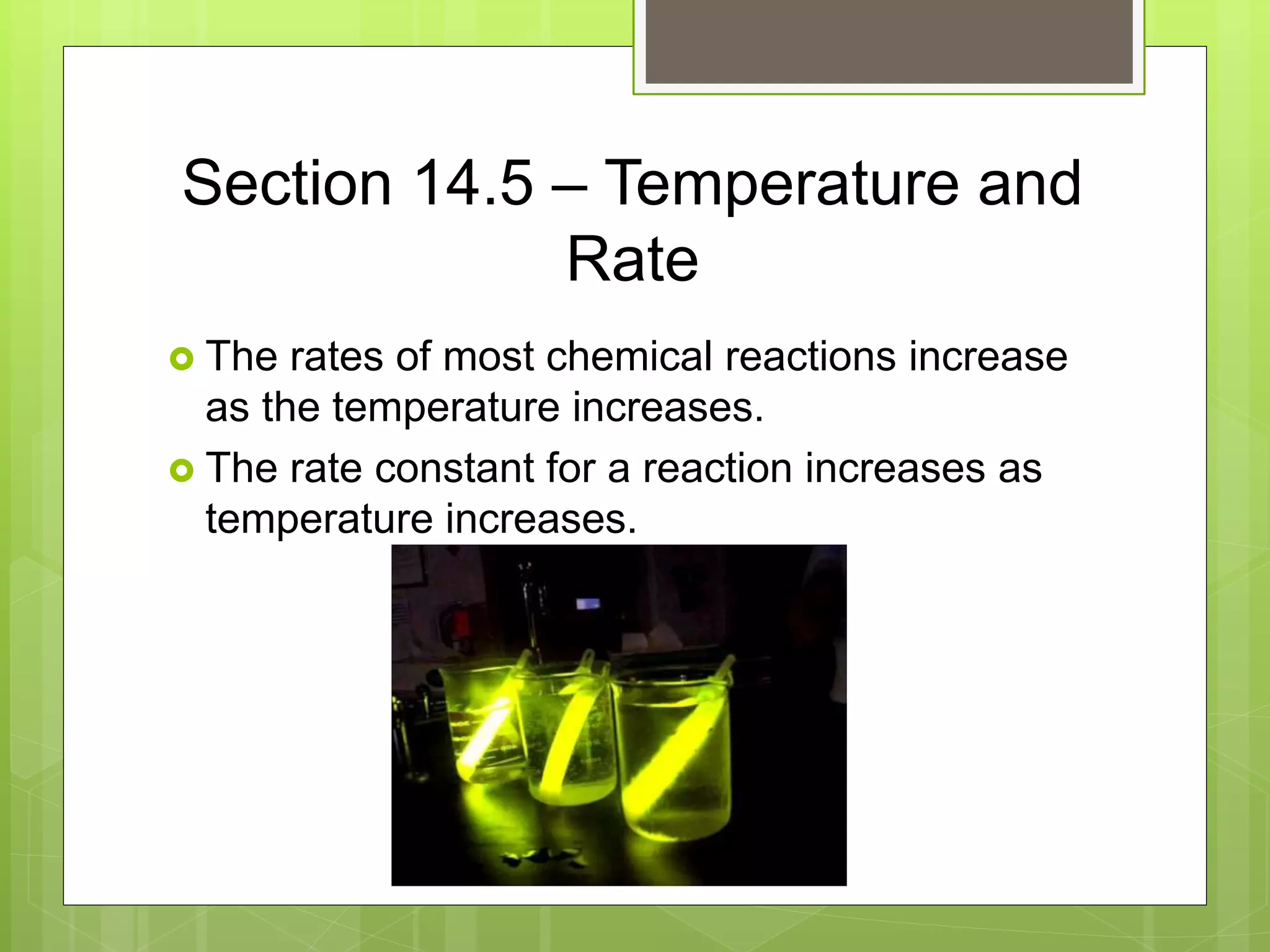
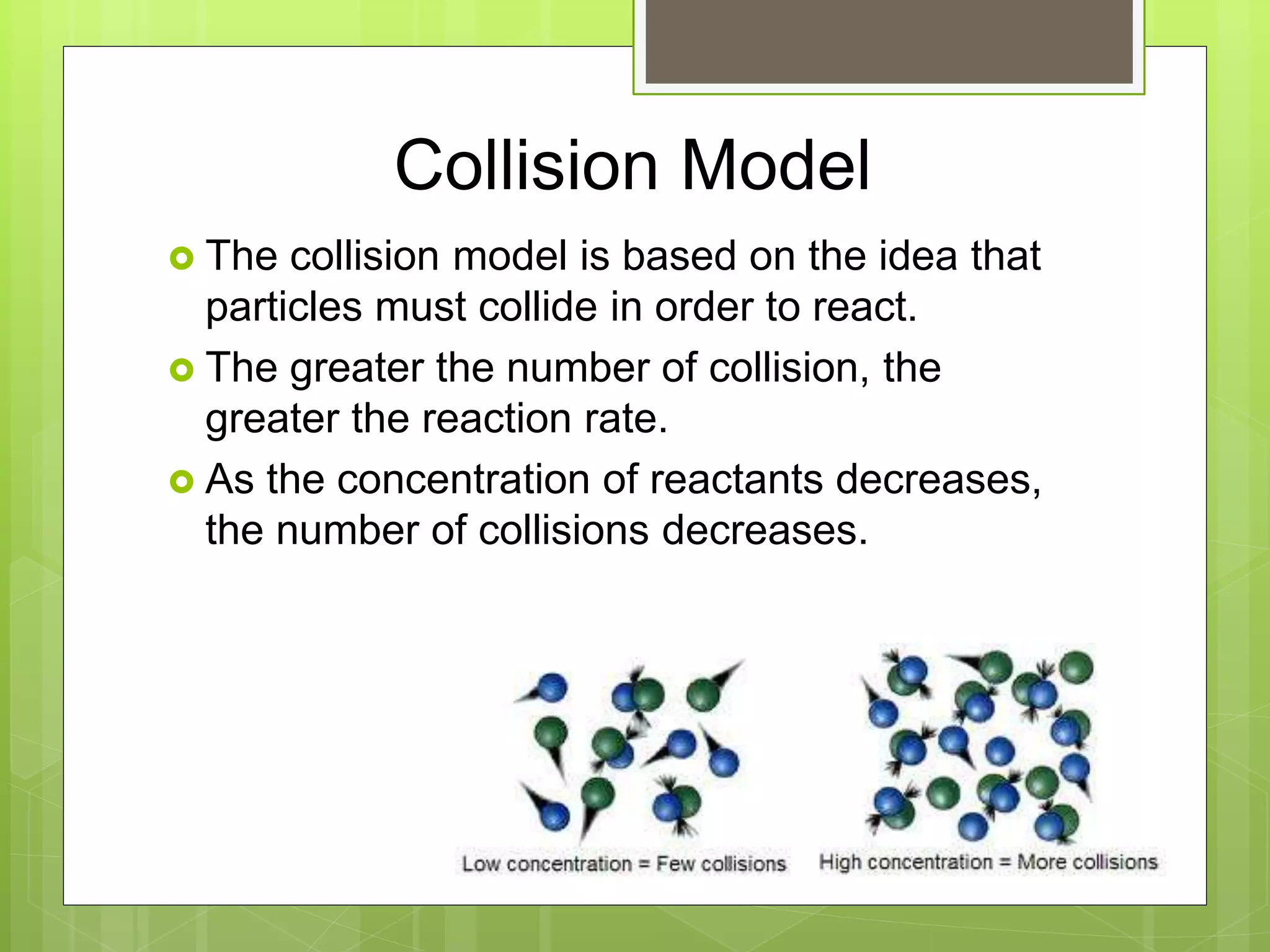
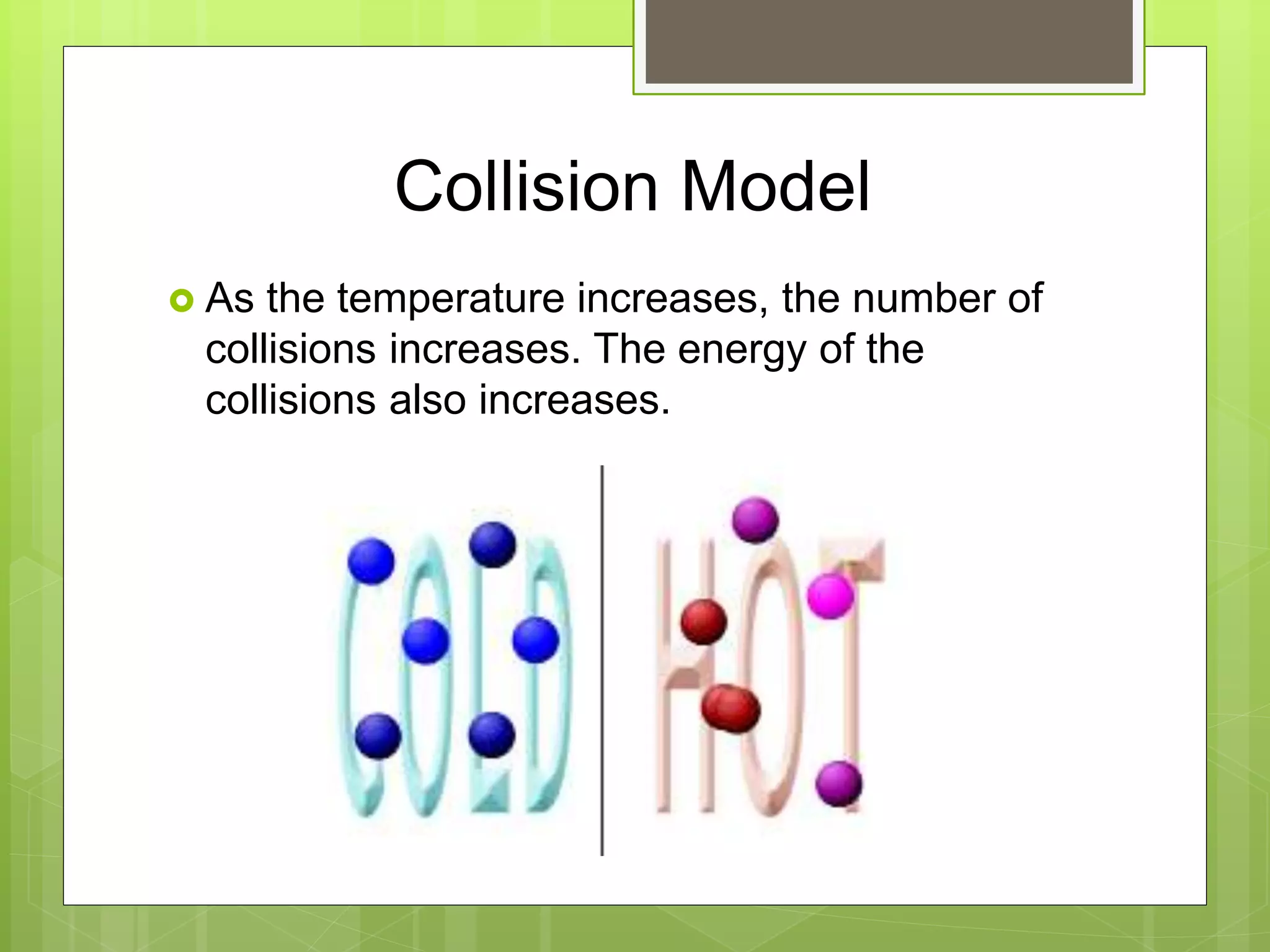
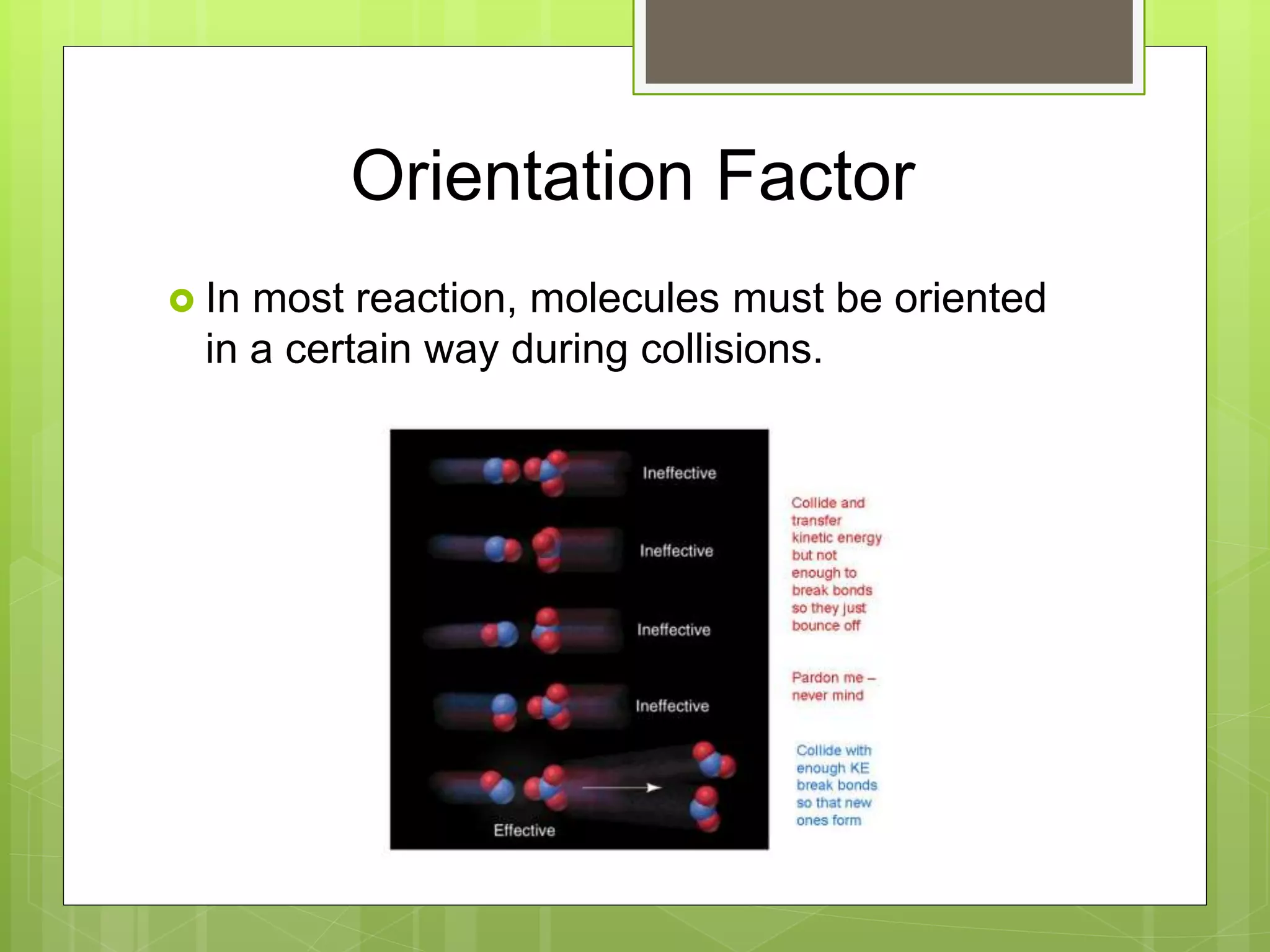
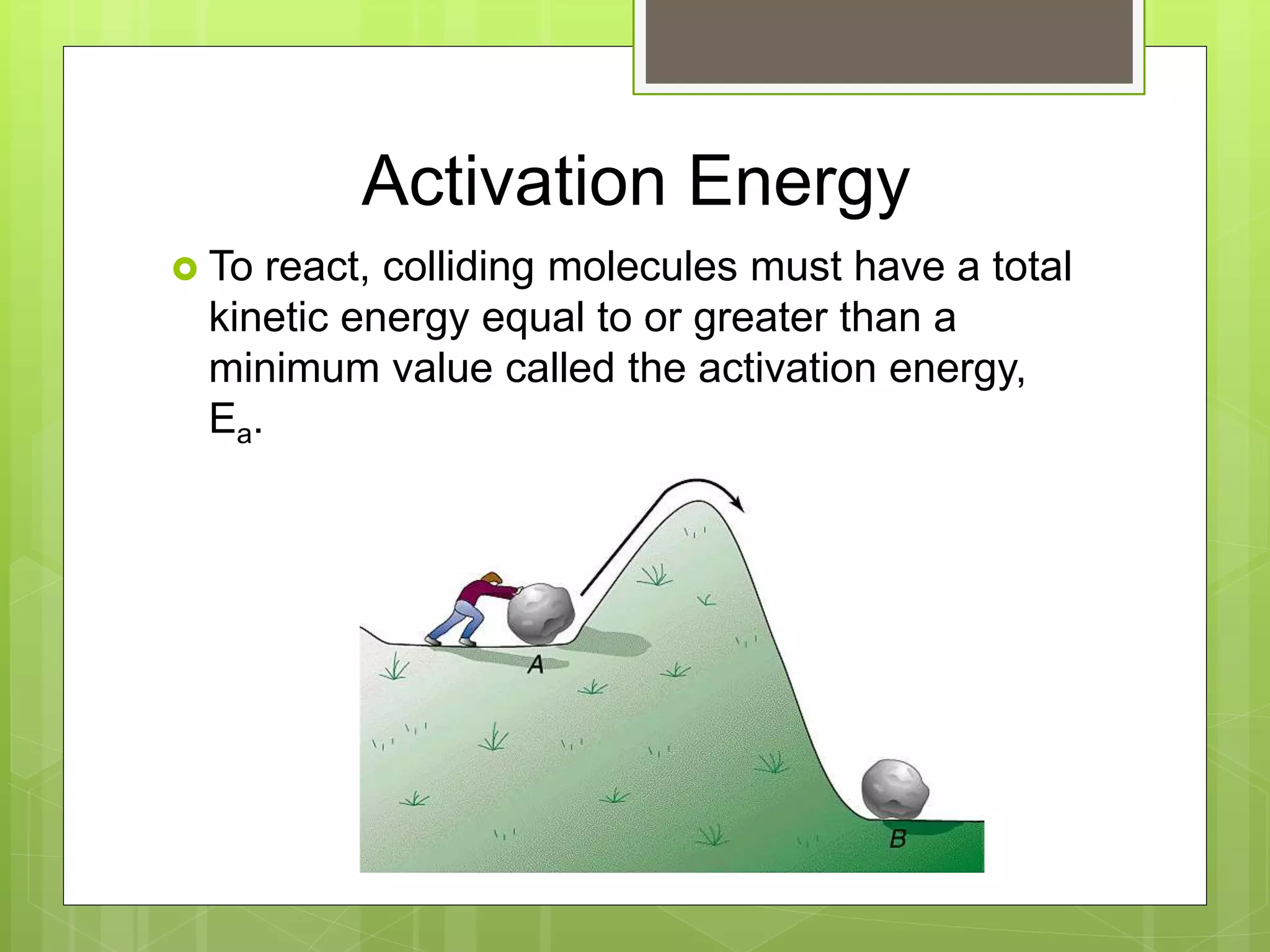

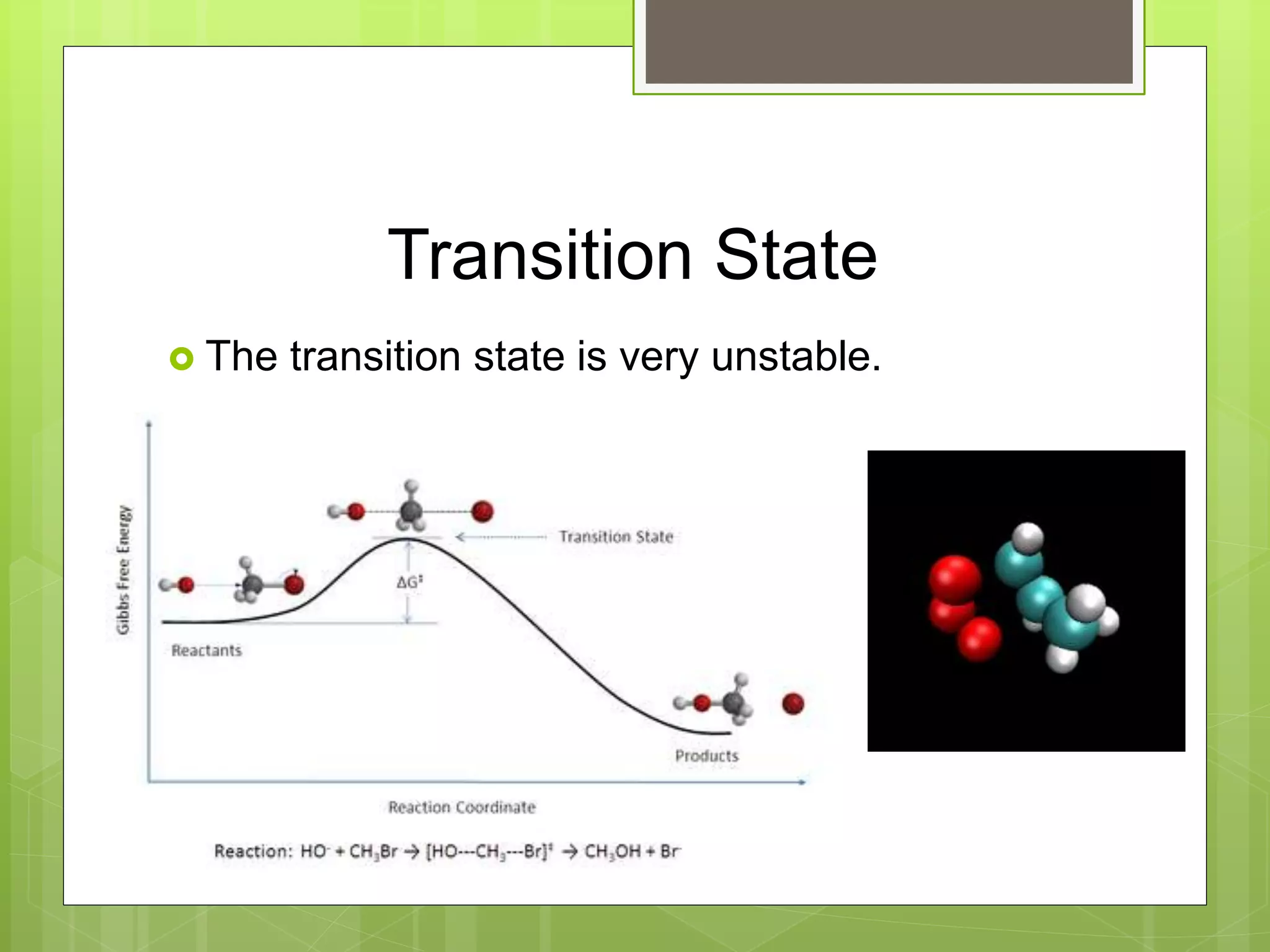
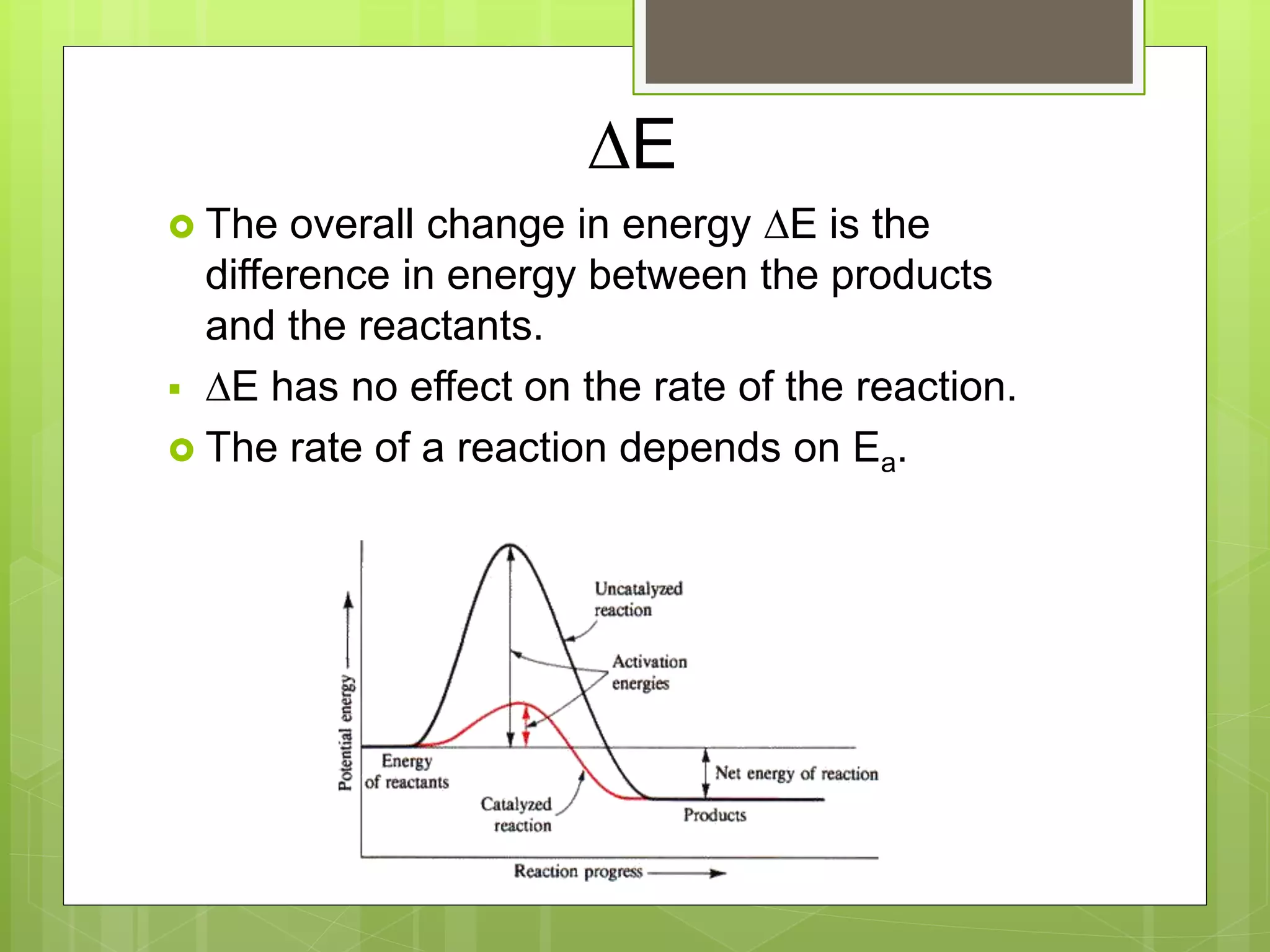
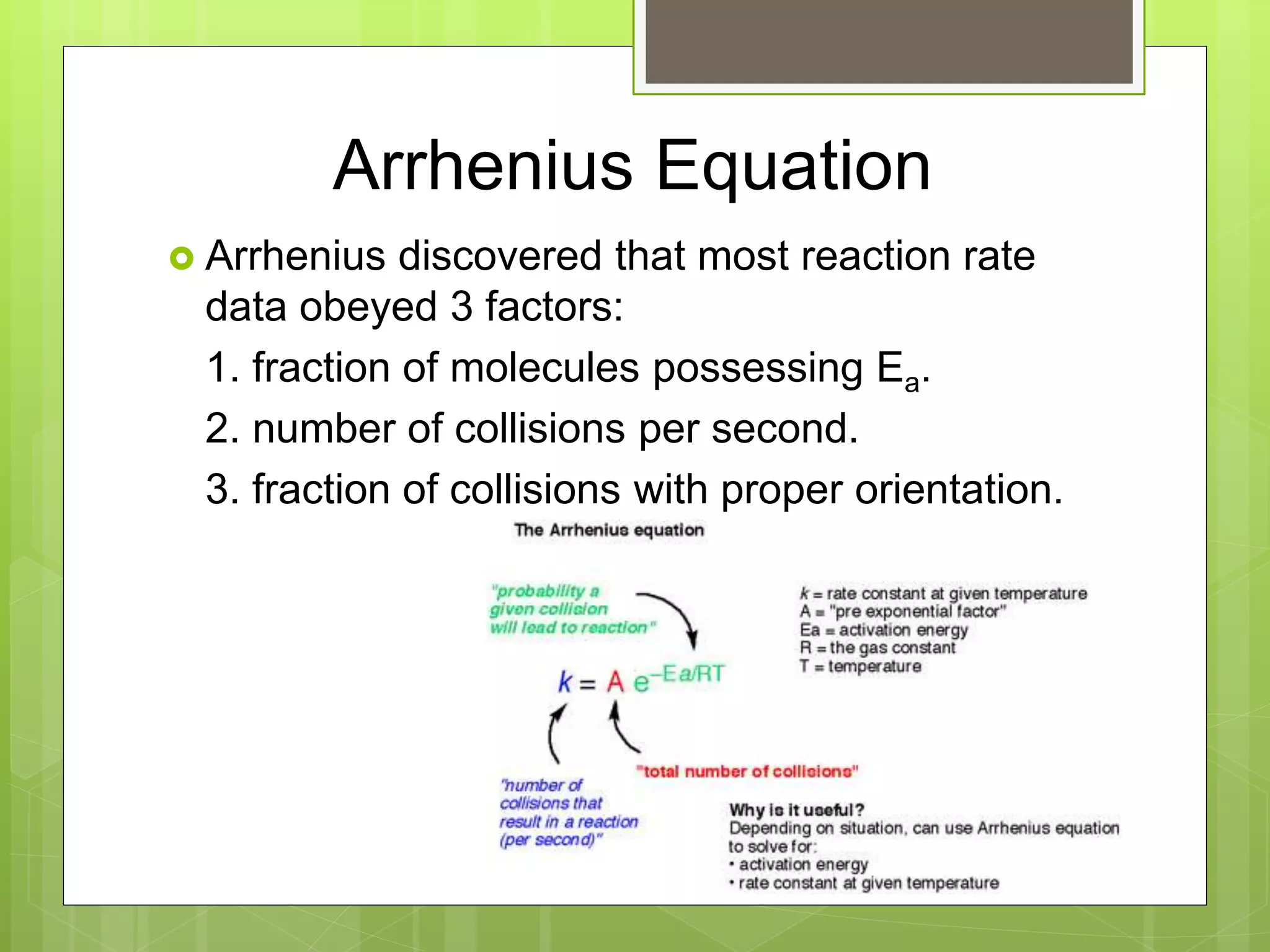

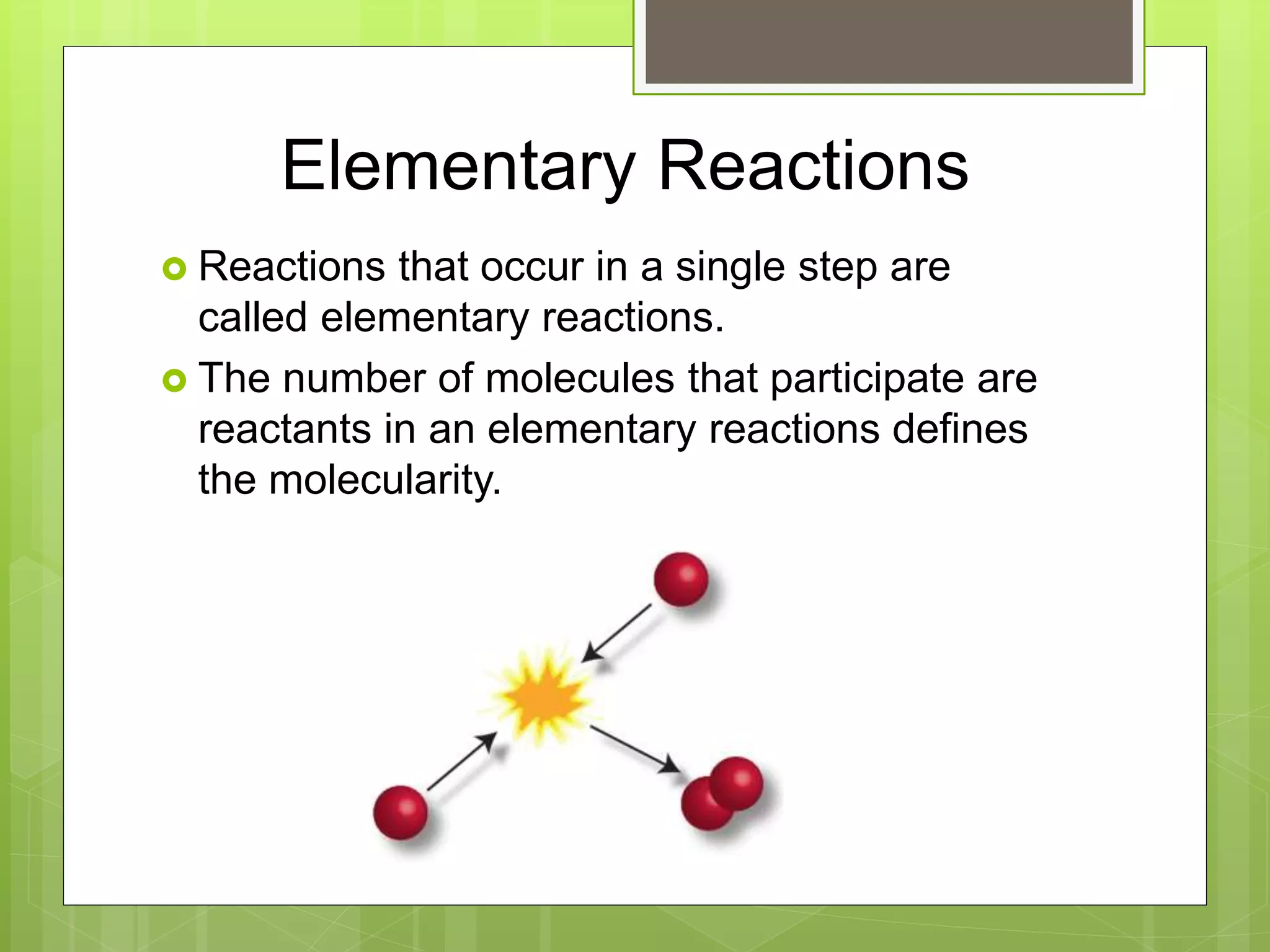
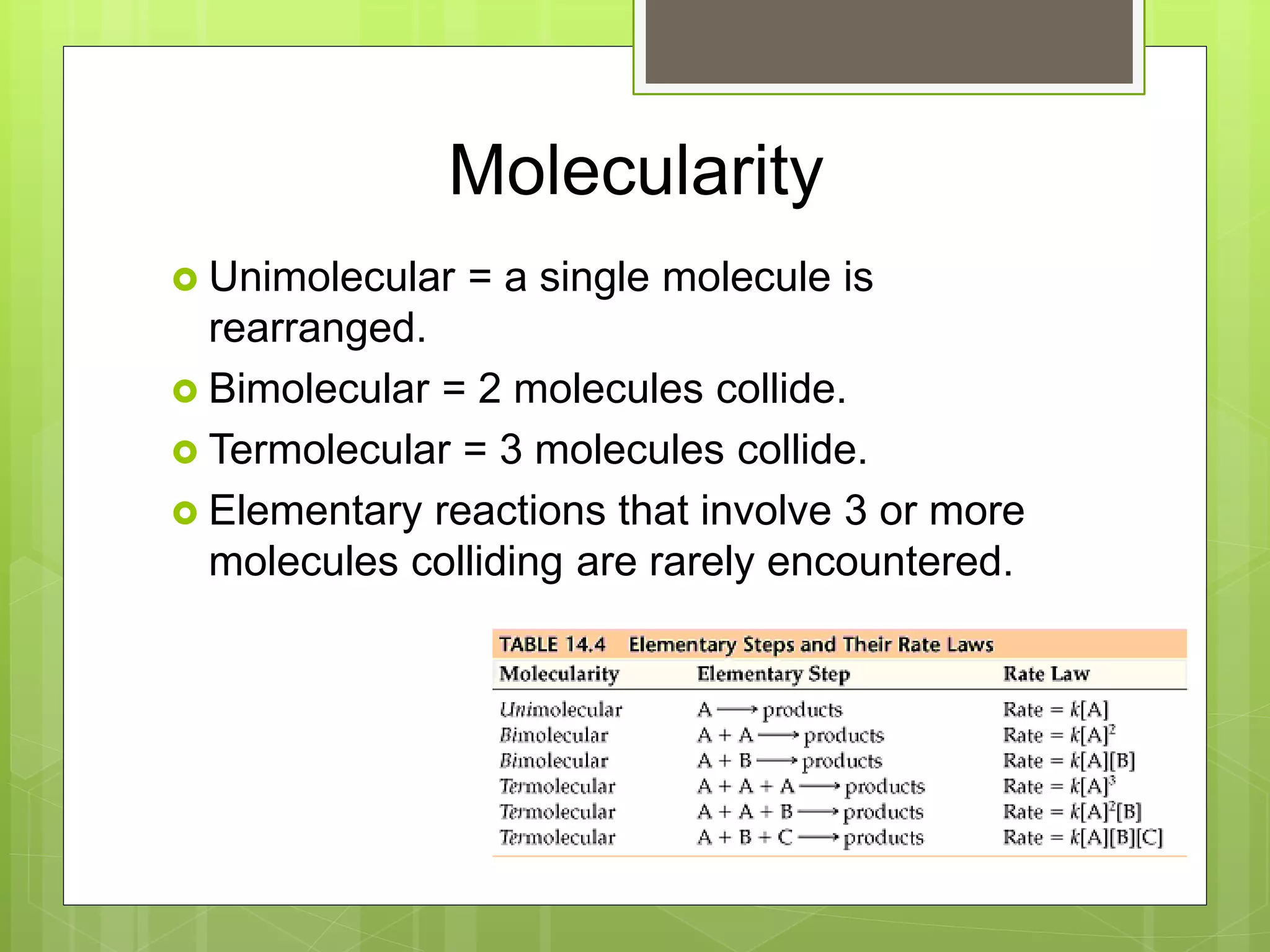

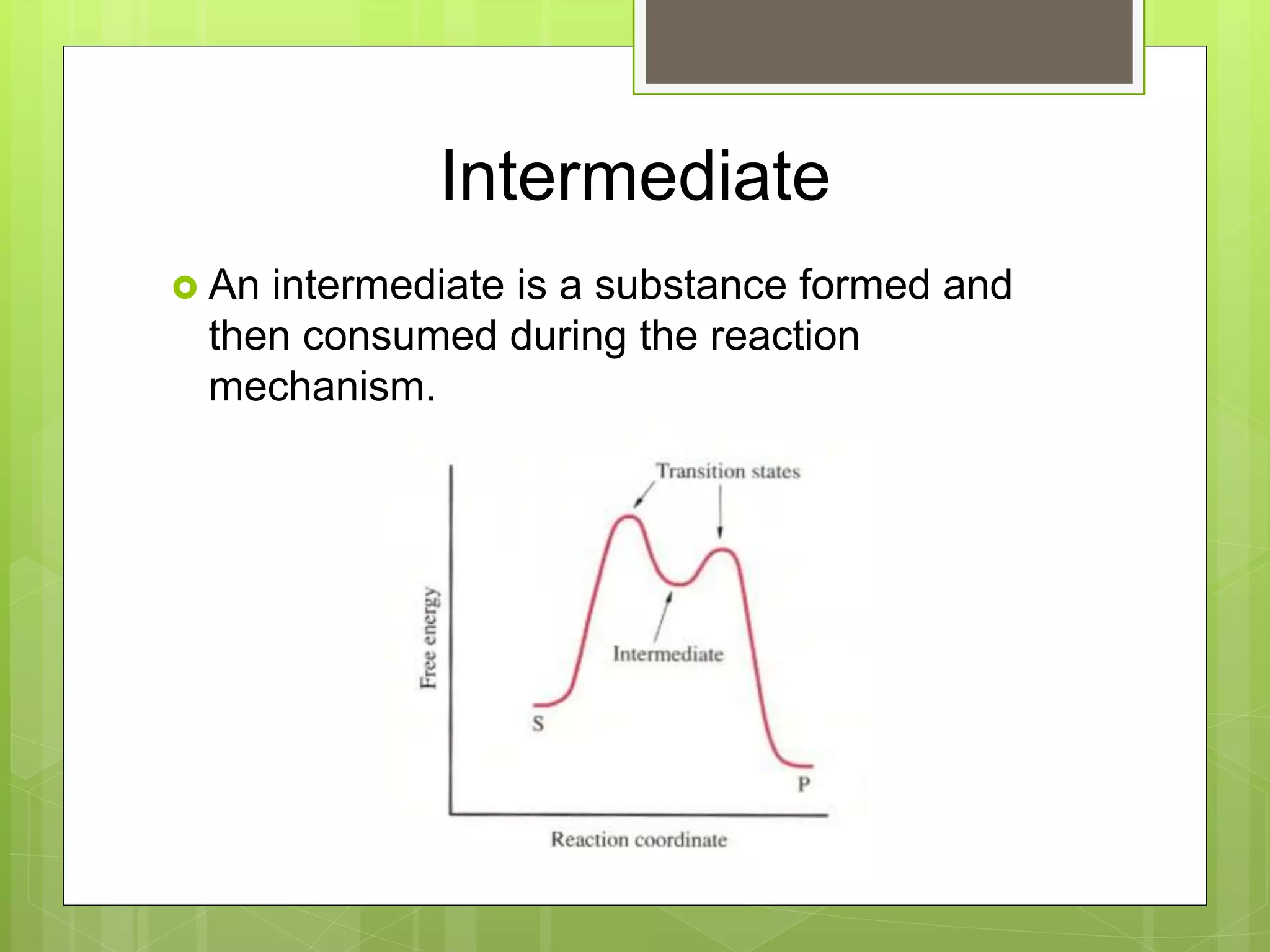

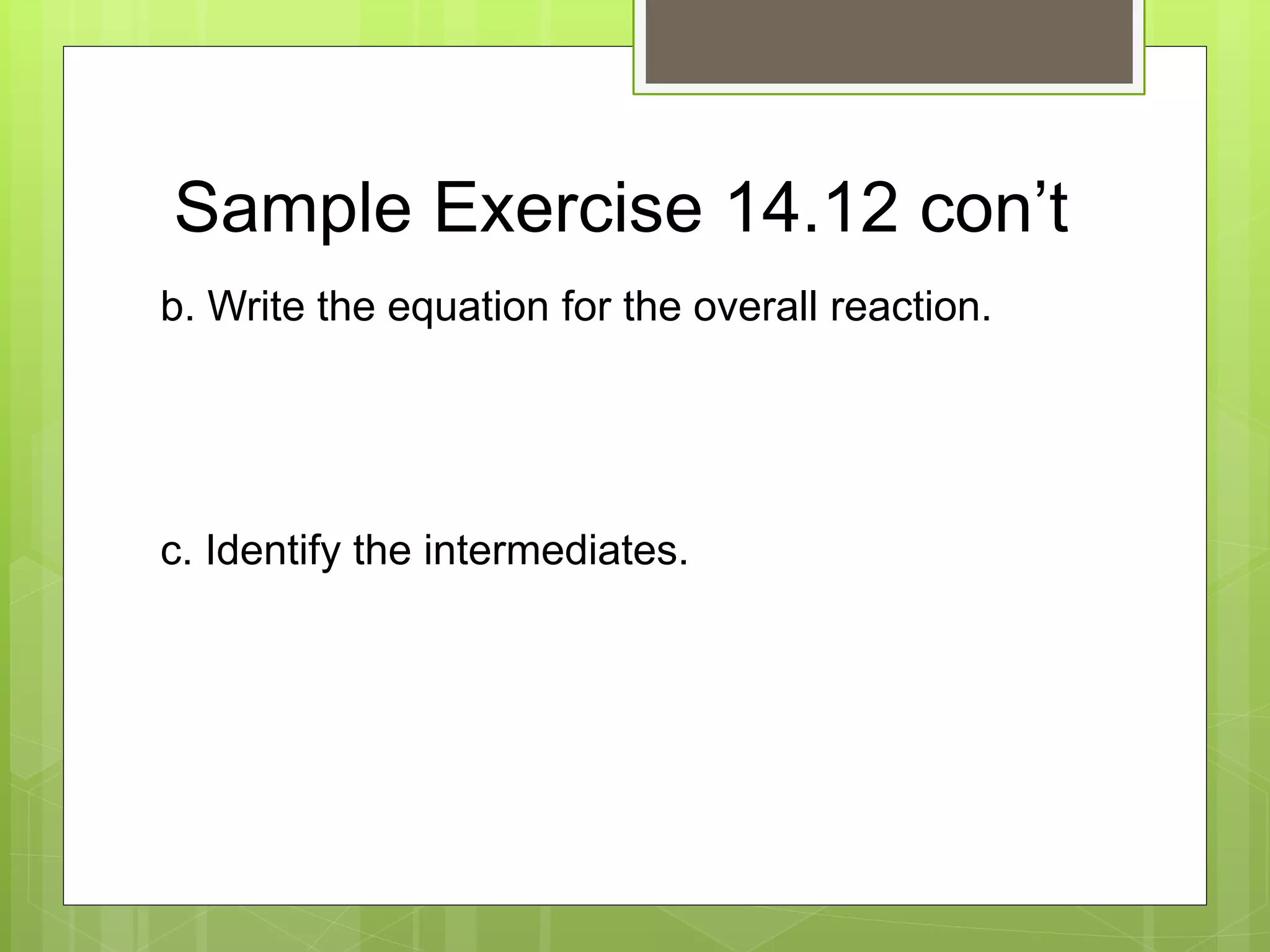
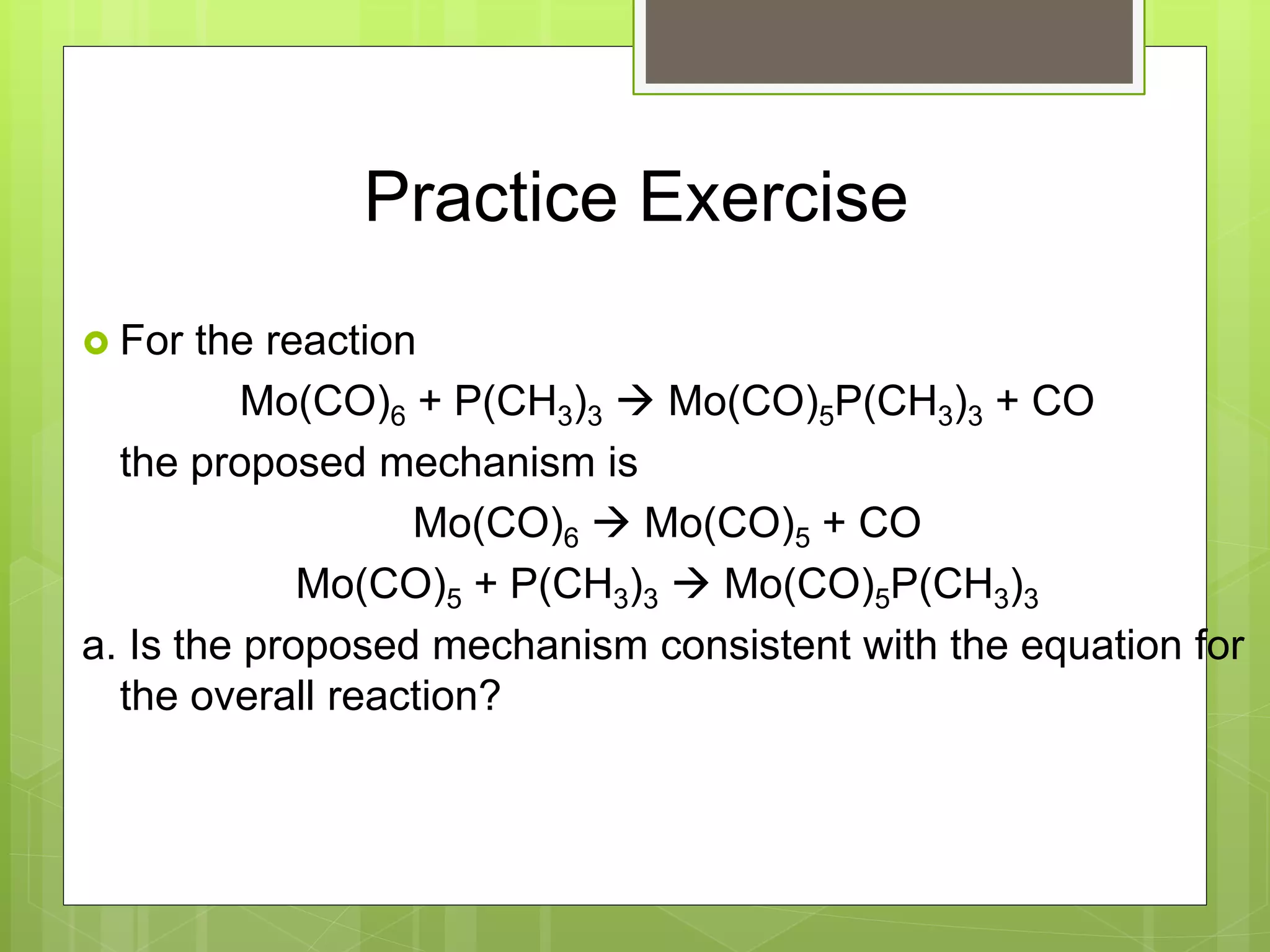

![Rate Laws
Every reaction is made up of a series of one
or more elementary steps, and the rate laws
and relative speeds of these steps will dictate
the overall rate law.
If a reaction is an elementary reaction, then its
rate law is based directly on its molecularity.
A products
Rate = k[A]](https://image.slidesharecdn.com/apchemistrychapter14powerpointforwebsite-230330152000-8a9d2131/75/AP-Chemistry-Chapter-14-Powerpoint-for-website-ppt-68-2048.jpg)
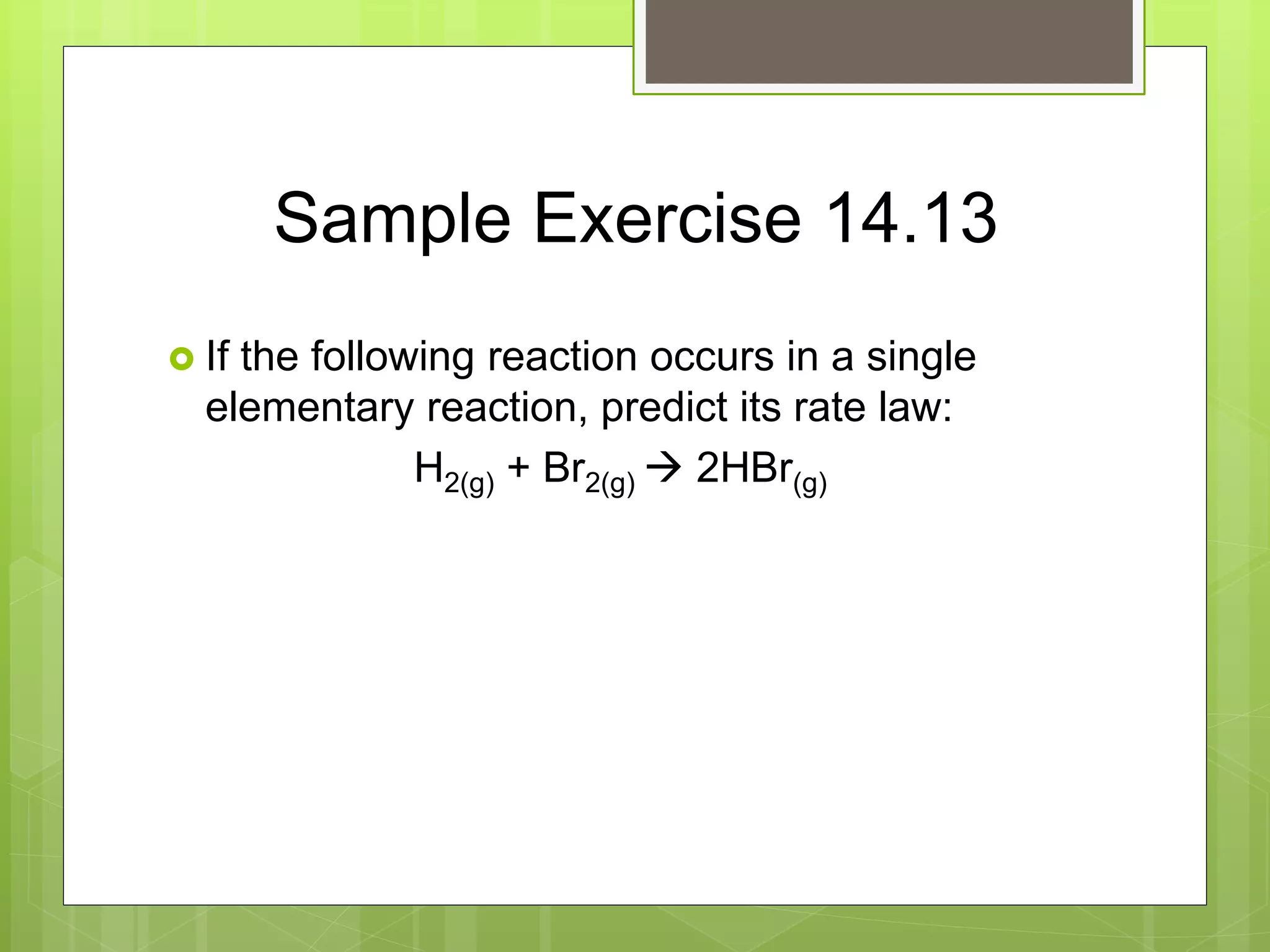


![Multistep Reactions
If the first step of the mechanism is slow, then
the rate is based on the reactants of step 1.
Rate = k[NO2]2](https://image.slidesharecdn.com/apchemistrychapter14powerpointforwebsite-230330152000-8a9d2131/75/AP-Chemistry-Chapter-14-Powerpoint-for-website-ppt-72-2048.jpg)
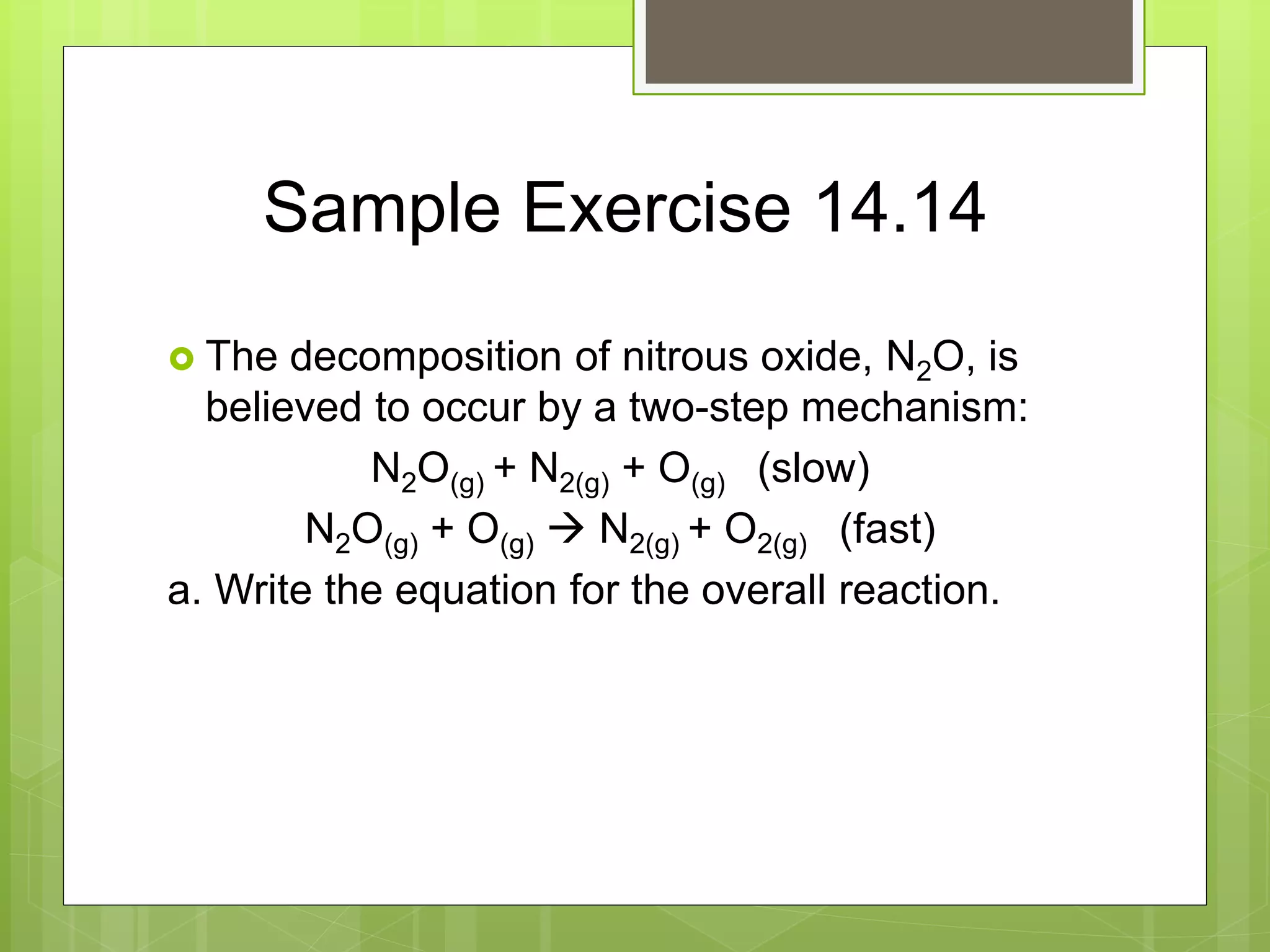
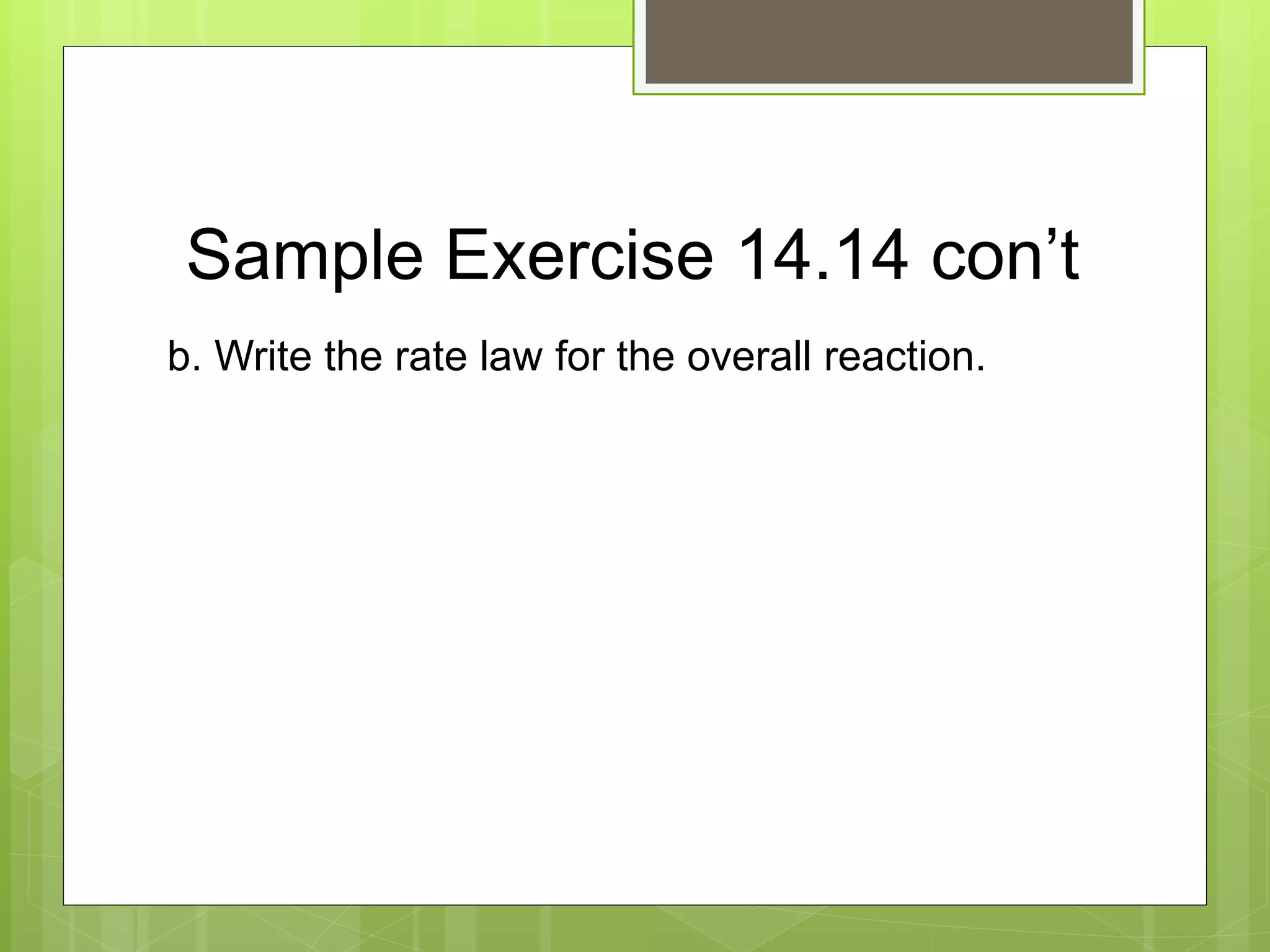
![Practice Exercise
Ozone reacts with nitrogen dioxide to produce
dinitrogen pentoxide and oxygen:
O3(g) + 2NO2(g) N2O5(g) + O2(g)
This reaction is believed to occur in two steps:
O3(g) + NO2(g) NO3(g) + O2(g)
NO3(g) + NO2(g) N2O5(g)
The experimental rate law is rate = k[O3][NO2].
What can you say about the relative rates of
the two steps of the mechanism?](https://image.slidesharecdn.com/apchemistrychapter14powerpointforwebsite-230330152000-8a9d2131/75/AP-Chemistry-Chapter-14-Powerpoint-for-website-ppt-75-2048.jpg)
![Fast Secondary Step
In general, when a fast step preceded a slow one, we
can solve for the concentration of an intermediate by
assuming that an equilibrium is established in the first
step.
Ex: Step 1: NO + Br2 NOBr2 (fast)
Step 2: NOBr2 + NO 2NOBr (slow)
Rate = k[NOBr2][NO] (cannot contain intermediate
[NOBr2] = [NO][Br2]
Rate = k[NO]2[Br2]](https://image.slidesharecdn.com/apchemistrychapter14powerpointforwebsite-230330152000-8a9d2131/75/AP-Chemistry-Chapter-14-Powerpoint-for-website-ppt-76-2048.jpg)
![Sample Exercise 14.15
Show that the following mechanism for
following reaction:
2NO(g) + Br2(g) 2NOBr(g)
Rate = k[NO]2[Br2]
Step 1: NO(g) + NO(g) N2O2(g) (fast)
Step 2: N2O2(g) + Br2(g) 2NOBr(g) (slow)](https://image.slidesharecdn.com/apchemistrychapter14powerpointforwebsite-230330152000-8a9d2131/75/AP-Chemistry-Chapter-14-Powerpoint-for-website-ppt-77-2048.jpg)
